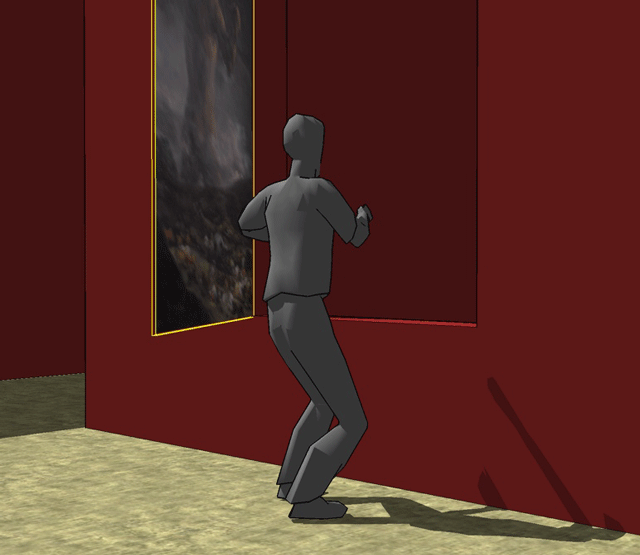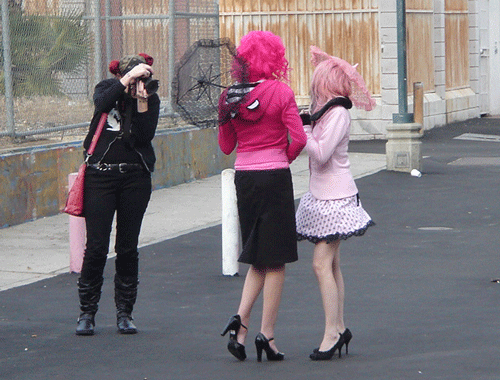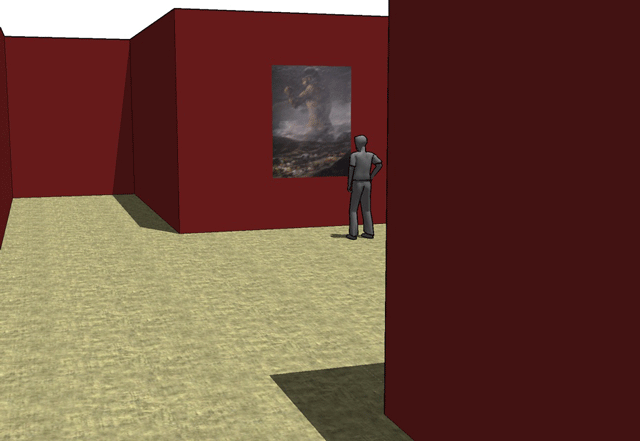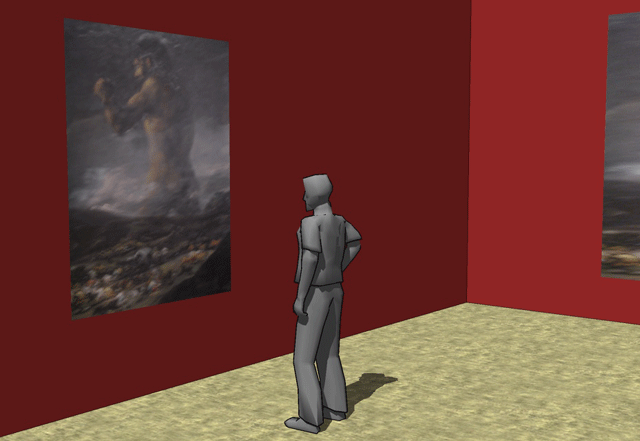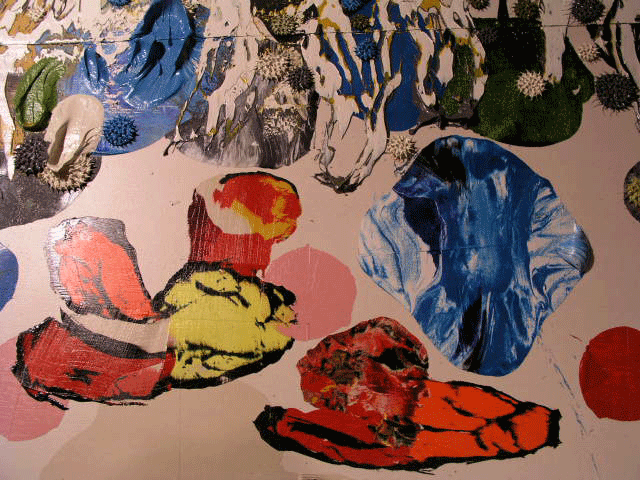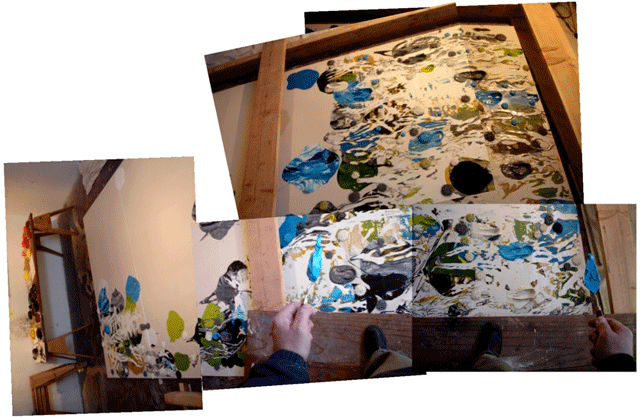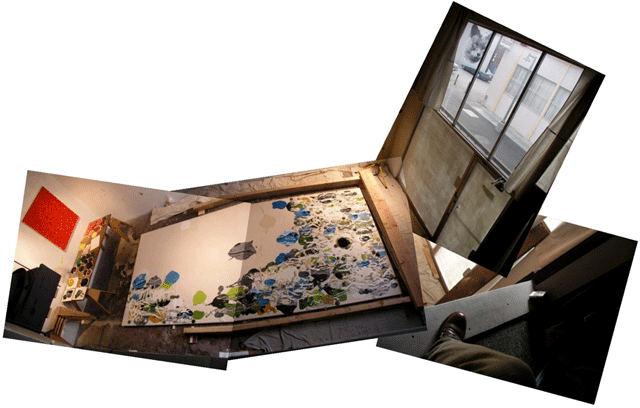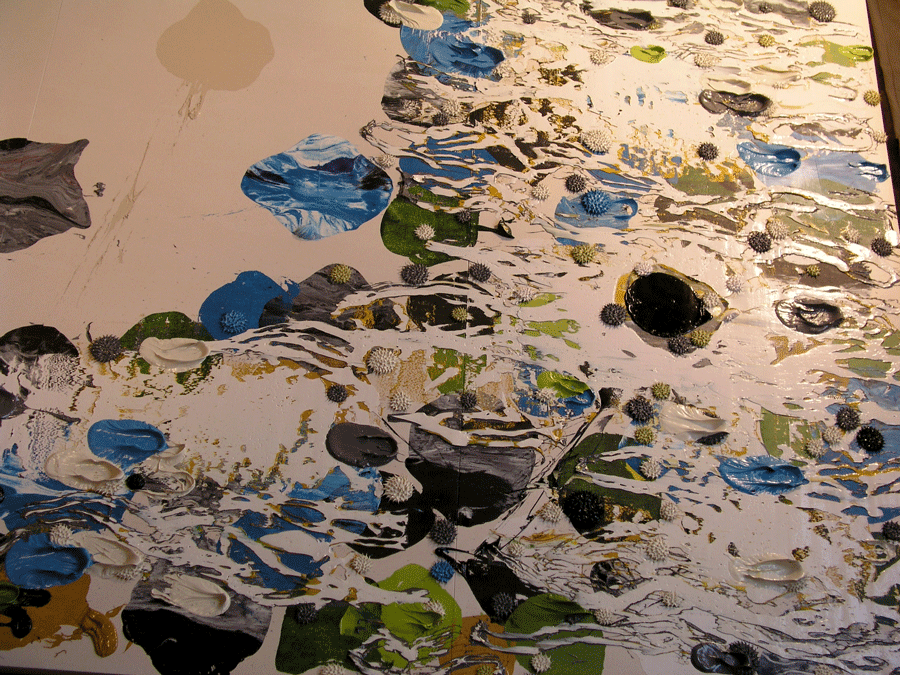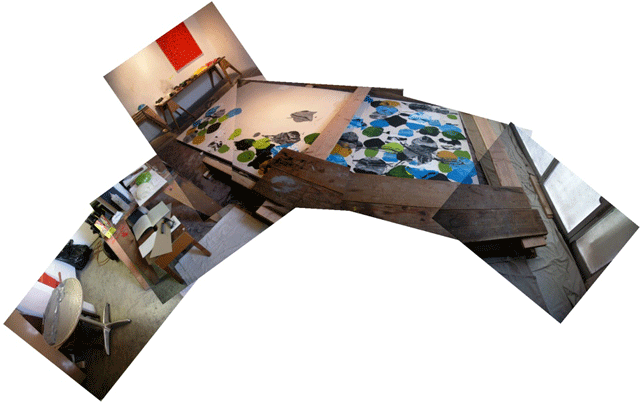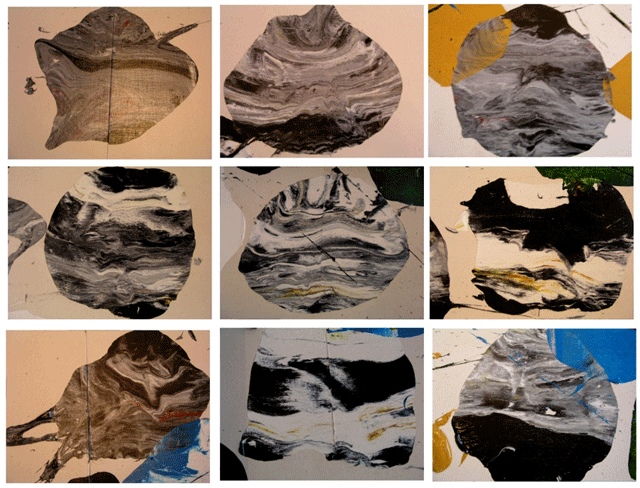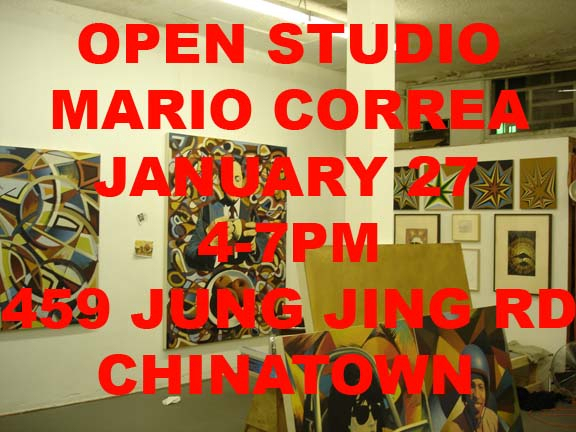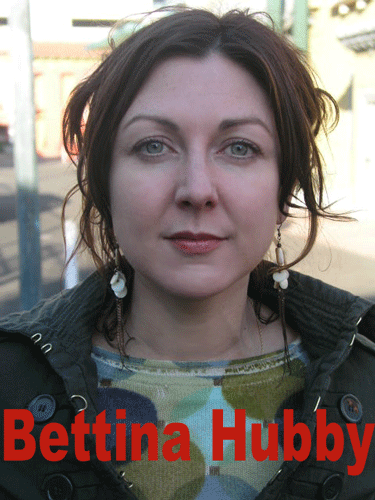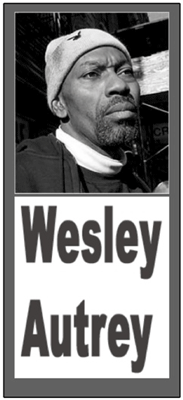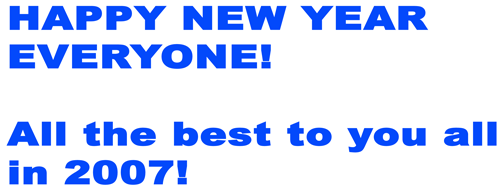January 31, 2007
January 30, 2007
Mario Correa
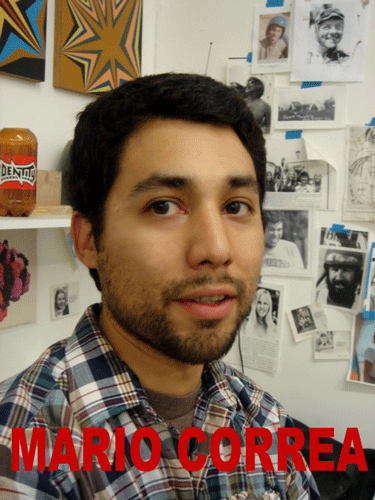
I was going to write that Mario is the king of brown. That sounded great to me, the implicatioins of brown, a manifesto on the color wheel, the ultimate mongrel, a Babel of color, the silty delta at the end of postmodern history...
Mario Correa opened his studio the other day to show his third cycle of work since he came out of CalArts:


I stopped in later to steal a slice of conversation on video. Check out the sly hip level screen capture investigative camera technique:
Ahhhh*, we were trying to remember Ellsworth Kelly. Kelly found pictorial composition in the chance encounter, he had a willingness to transform/encode/reduce three dimensional reality into the two needed for peictorial compostion, his inspiration was in the world at large. Along similar lines, Mario finds his inspiration in the mediated world of pop culture.
You can get a better grasp of it if you could see his previous two chapters of painting. Skateboard parks and boxing night in Vegas.
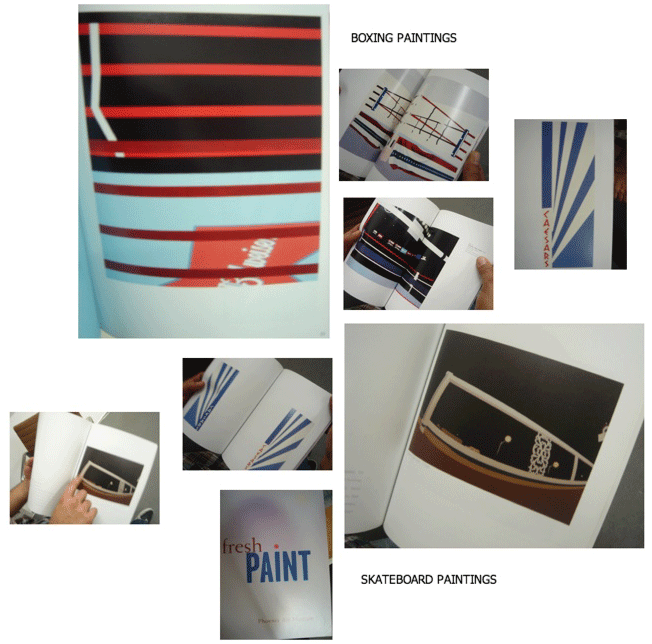
(*Yea, that's the way to edit a video, with memory loss. This is the really real here, folks.)
Pretending at Courage
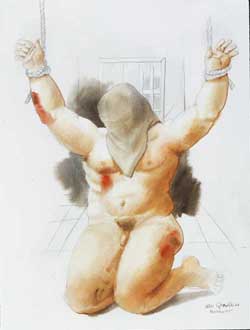
Courage, when considered of an artist, can mean one of several things, but it is the sense of risk that defines it.
It can mean a willingness to try what has not been done before. A chef may display courage, and risks the possibility that diners may gag on some brave new creation.-Benjamin Kerstein for KesherTalkIt can mean a willingness to risk the sacrifice of one's own career, like a pop musician being drawn to some other genre of music.
But it can no longer mean merely being offensive, engaging in political or social mockery, save in the case of a few certain targets, because now we all know where the risk is.
There is no risk in mocking politicians, now matter how intensively the abuse is served. There is no risk in mocking any establishements of American or Western culture- no harm will ensue. Performing the "Vagina Monologues" isn't an act of bravery, unless one does it in Saudi Arabia, perhaps. Every artist alive today now knows the limits: you can do this, which is as brave as taunting a stuffed teddy bear, or you can do that, which amounts to taunting a very hungry very uncaged bear.
Bravery, to an artist, is now an all or nothing thing. Leave the repressive regimes alone, and all your efforts, no matter how avante garde, provocative, or just plain offensive your work is, and you are just pretending at courage. Cross the line and say something about Islam, and your life is one the line.
All the gray areas have vanished in a week. It's as if mountaineers were to suddenly be faced with only two choices: Everest, or the plastic rock climbing wall. Long after this dies in the news, its going to echo in the heads of every writer, poet, standup comedian and performance artist- go after any target but the big one, and you're only faking it, playing it safe. It doesn't matter whether they admit it or not, whether they rewrite their material or not, it will be there, in their minds, and it will affect things. Even Margaret Cho knows she can curse Bush all she wants, but she'd better keep her mouth shut about you-know-who if whe doesn't want to bleed to death in the street. Speaking Truth to Power is only a heroic act if Power chooses to make an issue of it.
(Image source.)
Update: I liked the Botero sculptures installed in the streets of New York and Paris years ago, so this is not a gratuitous slam. But it looks like Botero is trying to take a Hiro Yamagata turn from here to here. Evidently, pushng soft buttery things into one's mouth is ultimately not enough. Prestige is bewitching indeed.
Bloody Hell.
Prestige is the blood of the artworld.
*
Corollaries:
1. Prestige changes generation to generation, decade to decade, moment to moment.
2. Remember to be the first audience and damn the consequences.
3. Time will certainly tell.
January 29, 2007
January 28, 2007
2nd Hand Symposium Report
I was able to get out and about late Saturday evening, after missing most of the big events going on in LA (I was about to list them all but shame caught up with me). Openings in ChinaTown were the draw, Mario Correa was opening his studio and Sister Gallery and Acu?a Hanson Gallery had openings too.
I asked a few friends who went to the USC Symposium earlier that day. What happened? Lane Reylea held forth and said a few profound things... none of which could be recalled. Bruce Hainley was brilliant, keeping quiet until nearly the end of the afternoon session when he got all volcanic. None of this vulcanism could be summarized afterwards, either.
One buzzword floated to the surface of my freind's memories: deskilling.
Deskilling is the name of an effort on the part of ambitous graduate art school programs to roll back the emphasis on technique inculcated in undergraduate art school. Evidently, theory and technique are taken to be antithetical, antagonistic. They used to call this "post studio" in CalArts back in the nineties.
Post studio was a conceptualist's triumph over studio practice, the status of the latter was lowered to spotlight the virtues of the former. I have heard tell that much of the attitude of the students of that time was that technique should be dumbed down, a kind of baby talk in art media. My take was that the generation of art students in the early nineties realized that the agenda of the 80's (critical theory) couldn't be carried on after the fall of the Berlin Wall and since they could not take the Oedipal turn and slay the father ("to question the answers given to us in school", L. Wiener), they infantalized the appearance of the medium even as they sought to raise the bar in the world of letters. Fair enough. This is a strong indication that the conceptual impulse that informed postmodern art from its inception with Pop art at the beginning of the sixties has been going strong for more than fifty years now.
Ok. That was then, this is now... but now is then?
This sounds like the same dynamic of the rebellion against the retrograde that I tried to describe in an earlier post. A small but important caveat: I didn't go to undergrad art school. When I left the Navy years ago with an eye to do what I am doing now, I substituted undergrad architecture for undergrad art. Call me naive, idealistic, easily impressed with the Renaissance Man model, hare brained, whatever... that's what I did and for better or worse, here is where I am now.
But there is one thing that I learned in architecture school: that there is no easy nor desireable separation between the ability to handle the medium and the ability to conceptualize the art form. What happened to fusion: finding theory in skills, finding skills in theory? Is the world of materiality so easily substituted by the world of letters?
Skillz.
That's the term the kids use in computer gaming. Can we learn something from the gamers? Maybe there's a difference between skills and technique? In the latter, the means is the end... in the former, the means is deployed at its highest level so that the end can be served cold (like revenge) and with bravado. Perhaps skills instruction should be minimal and skillz instruction should be maximal?
Just a thought.
Silly me... there is no end game in art, afterall.
January 26, 2007
Dang. (the USC Symposium)
Alas, the Future of Art School may not be in my future! I might not be able to make it to the Symposium tomorrow, or at best I can try to get in sometime midway.
I was able to get a copy of the Primer, available here.
One last note: I have heard tell that at least for two art schools in Southern California, there is a problem with old guard tenured faculty who tend to rest on their laurels and take a permanent vacation from the streetfighting arena (I was going to write "marketplace") of their professions/disciplines. Slackers by another name, these professors represent a retrograde tendency in the academy, a kind of intellectual/professional/creative torpor that acts as a drag to progress within the university.
(Caveat: I tend to wince at the formulation of this thought. I don't mean to portray legacy faculty in such a negative light... surely many such faculty are carrying much water for their departments, surely many are isolated in their respective tunnel of interests, surely the human tendency to form rivalries and instinct to compete can make such distinctions a handy weapon to unfairly gain advantage. But given this caveat, all schools suffer from such topor. The question here is whether it is at such a level that harms the educational mission.)
In one school, most of these slacker faculty are monolithic in terms of cultural diversity, their interest in expanding the multicultural dialog nil. As a result, the students hunger for diversity of various kinds -especially cultural- and thus agitate fruitlessly petitioning for radical exemplars in the public sphere to contribute to the intellectual life in their schools. This situation becomes more strange in that contemporary culture has overtaken university culture in the progess of the that particular (multicultural) debate, leaving the university mired in a public argument that is 20 years or so old. The trouble is that the students are only dimly aware -if at all- that their apparent sophistication (purchased at so dear a price) is shop worn upon reciept.
In another school, slacker faculty have retired their professional practice on the sly. No longer having to struggle for success within their work, they go through the motions within the institution. As the saying goes: "Good enough for government work", the temptation to punch the clock has evicerated the intellectual ideals that the sanctuary within academia was meant to inspire. As a result, students model themselves on degraded standards of excellence, oblivious to the sharpness of the cultural streetfight that is out in the world. Young faculty when confronted with the problem of intellectual (a.k.a. theory) torpor, respond by insisting on more intellectuality (theory) for the students. In an era where theory itself needs its own comeuppance so that it too can evolve, the strategy of increasing the volume of theorization seems to me that it would only compound the problem with another orthodoxy. What is desireable is to acquaint students with the heterodoxy of the dialog in the street. But until the slacker faculty get a life within their profession, this source of the problem will continue to be an drag on any ambition for acculturating students to the "cutting edge" however it is defined.
It's worth asking at this point: is the university the proper place for the "cutting edge"? Perhaps that is what the street is for? And the university is best reserved for something else? I ask because I really don't know. I start thinking of institutions like the military, who have the pressing need to adapt to a changing world... and they too have similar problems with creeping bureaucratization which is overcome only with extreme effort.
As I like to say: Bureaucracy is the natural enemy of art.
The sobering thought is that reform within the institutions of higher learning will be extremely difficult, if it is possible at all. The problem of slacker faculty can be joined by bloated budgets/tuitions, the lack of financial transparency/accountability, and a growing irrelevance in a time where technological change can spawn and exhaust several careers within a person's lifetime. Our universities need their own reformation but the problem is that since they were designed to provide a refuge from the markeplace, academia lacks the systems for self correction (creative destruction). And thus the problem compounds.
What we need is to radically imagine a university 2.0... but how to start?
Eulogy of Autarky
Sign and Sight feature an essay by Pascal Bruckner, which starts off like this:
Enlightenment fundamentalism or racism of the anti-racists?It's worth reading of course and again, I can only find a sizeable portion to excerpt, after the jump:Pascal Bruckner defends Ayaan Hirsi Ali against Ian Buruma and Timothy Garton Ash, condemning their idea of multiculturalism for chaining people to their roots
"What to say to a man who tells you he prefers to obey God than to obey men, and who is consequently sure of entering the gates of Heaven by slitting your throat?" - Voltaire
"Colonisation and slavery have created a sentiment of culpability in the West that leads people to adulate foreign traditions. This is a lazy, even racist attitude." ? Ayaan Hirsi Ali
This vicious mechanism is well known. Those who revolt against barbarism are themselves accused of being barbarians. In politics as in philosophy, the equals sign is always an abdication. If thinking involves weighing one's words to name the world well, drawing comparisons in other words, then levelling distinctions testifies to intellectual bankruptcy. Shouting CRS = SS as in May '68, making Bush = Bin Laden or equating Voltaire to Savonarola is giving cheap satisfaction to questionable approximations. Similarly, the Enlightenment is often depicted as nothing but another religion, as mad and intransigent as the Catholicism of the Inquisition or radical Islam. After Heidegger, a whole run of thinkers from Gadamer to Derrida have contested the claims of the Enlightenment to embody a new age of self-conscious history. On the contrary, they say, all the evils of our epoch were spawned by this philosophical and literary episode: capitalism, colonialism, totalitarianism. For them, criticism of prejudices is nothing but a prejudice itself, proving that humanity is incapable of self-reflection. For them, the chimeras of certain men of letters who were keen to make a clean slate of God and revelation, were responsible for plunging Europe into darkness. In an abominable dialectic, the dawn of reason gave birth to nothing but monsters (Horkheimer, Adorno).The entire history of the 20th century attests to the fanaticism of modernity. And it's incontestable that the belief in progress has taken on the aspect of a faith, with its high priests from Saint Simon to August Comte, not forgetting Victor Hugo. The hideous secular religions of Nazism and communism, with their deadly rituals and mass massacres, were just as gruesome as the worst theocracies - of which they, at least as far as communism goes, considered themselves the radical negation. More people were killed in opposition to God in the 20th century than in the name of God. No matter that first Nazism and then communism were defeated by democratic regimes inspired by the Enlightenment, human rights, tolerance and pluralism. Luckily, Romanticism mitigated the abstraction of the Enlightenment and its claims to having created a new man, freed from religious sentiment and things of the flesh.
Today we are heirs to both movements, and understand how to reconcile the particularity of national, linguistic and cultural ties with the universality of the human race. Modernity has been self-critical and suspicious of its own ideals for a long time now, denouncing the sacralisation of an insane reason that was blind to its own zeal. In a word, it acquired a certain wisdom and an understanding of its limits. The Enlightenment, in turn, showed itself capable of reviewing its mistakes. Denouncing the excesses of the Enlightenment in the concepts that it forged means being true to its spirit. These concepts are part and parcel of the contemporary make up, to the point that even religious fanatics make use of them to promote their cause. Whether we like it or not, we are the sons of this controversial century, compelled to damn our fathers in the language they bequeathed to us. And since the Enlightenment triumphed even over its worst enemies, there is no doubt that it will also strike down the Islamist hydra, provided it believes in itself and abstains from condemning the rare reformers of Islam to the darkness of reprobation.
Today we combine two concepts of liberty: one has its origins in the 18th century, founded on emancipation from tradition and authority. The other, originating in anti-imperialist anthropology, is based on the equal dignity of cultures which could not be evaluated merely on the basis of our criteria. Relativism demands that we see our values simply as the beliefs of the particular tribe we call the West. Multiculturalism is the result of this process. Born in Canada in 1971, it's principle aim is to assure the peaceful cohabitation of populations of different ethnic or racial origins on the same territory. In multiculturalism, every human group has a singularity and legitimacy that form the basis of its right to exist, conditioning its interaction with others. The criteria of just and unjust, criminal and barbarian, disappear before the absolute criterion of respect for difference. There is no longer any eternal truth: the belief in this stems from na?ve ethnocentrism.
Philippines, the Model
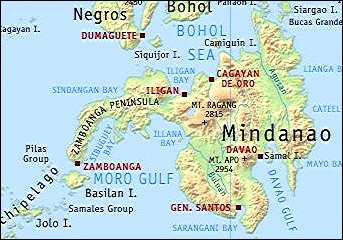
The long war between Manila and the Muslim Moros in the Philippines is fought in the shadows; a deadly mirror image of the terrorist wars in the Middle East. The difference is that the search for a solution has been going on for more than a hundred years. [First of two parts.]
World archipelago, meet the Philippine archipelago. Richard Fernandez of The Belmont Club has returned from Mindanao and he sketches some history of the guerilla movements in the southern Philippines for Pajamas Media:

They say the desert is vast, but the sea is vaster. Many Muslims in the south are a sea-people, accustomed from early youth and conditioned by immemorial memory to live on the sea; and certain tribes actually build their homes on piles six feet above the high water mark. These descendants of the Moro pirates which assailed the Spanish forts tie up their outriggers like a horse to a hitching post at the foot of their homes at sea. The casual visitor to Zamboanga city will see Muslim families living on small outriggers; sleeping, eating and performing all the daily tasks that others are accustomed to on dry land.
Were you to walk the beach by night there would be lights moving beneath the waves. The traditional Muslim pearl diver has enlisted technology and evolved into the busero, a spear fisherman capable of staying forty feet below the surface half an hour at a time, sustained by a small plastic hose fed by an aquarium oxygen pump. With the slender source of oxygen like a straw between his lips, a waterproof flashlight in one hand and a rubber-band powered speargun in the other the busero?s light attracts the curious fish beneath the harbor into lethal range.
Cool, night diving. I can relate.
If you liked my previous post JUNGLE PATROL, this will bring the story up to the 20th century for you.
January 24, 2007
"Who are we?"
Modern liberal societies have weak collective identities. Postmodern elites, especially in Europe, feel that they have evolved beyond identities defined by religion and nation. But if our societies cannot assert positive liberal values, they may be challenged by migrants who are more sure of who they are.
-Francis Fukuyama
This was such a powerful essay, the most minimal excerpt I could find was a sizeable bite out of the midsection:
Worth reading in full, several times. I never thought I'd recommend Fukiyama so heartily. But he spotlights the nub of the problem of Islamofascism in a wider context of the whiplashed acculturation of atavistic societies who force us to help them accelerate -kicking and screaming- into modernity:
The argument that contemporary radical Islamism is a form of identity politics has been made most forcefully by the French scholar Olivier Roy in his 2004 book Globalised Islam. According to Roy, the root of radical Islamism is not cultural?that is, it is not a by-product of something inherent in Islam or the culture that this religion has produced. Rather, he argues, radical Islamism has emerged because Islam has become "deterritorialised" in such a way as to throw open the whole question of Muslim identity.(Wikipedia Link Mine on the Double G's... you're welcome.)The question of identity does not come up at all in traditional Muslim societies, as it did not in traditional Christian societies. In a traditional Muslim society, an individual's identity is given by that person's parents and social environment; everything?from one's tribe and kin to the local imam to the political structure of the state?anchors one's identity in a particular branch of Islamic faith. It is not a matter of choice. Like Judaism, Islam is a highly legalistic religion, meaning that religious belief consists of conformity to a set of externally determined social rules. These rules are highly localised in accordance with the traditions, customs, saints and practices of specific places. Traditional religiosity is not universalistic, despite Islam's doctrinal universalism.
According to Roy, identity becomes problematic precisely when Muslims leave traditional Muslim societies by, for example, emigrating to western Europe. One's identity as a Muslim is no longer supported by the outside society; indeed, there is strong pressure to conform to the west's prevailing cultural norms. The question of authenticity arises in a way that it never did in the traditional society, since there is now a gap between one's inner identity as a Muslim and one's behaviour vis-?-vis the surrounding society. This explains the constant questioning of imams on Islamic websites about what is haram (prohibited) or halal (permitted). But in Saudi Arabia, the question of whether it is haram to shake hands with a female professor, for example, never comes up because such a social category hardly exists.
Radical Islamism and jihadism arise in response to the resulting quest for identity. Those ideologies can answer the question of "Who am I?" posed by a young Muslim in Holland or France: you are a member of a global umma defined by adherence to a universal Islamic doctrine that has been stripped of all of its local customs, saints, traditions and the like. Muslim identity thus becomes a matter of inner belief rather than outward conformity to social practice. Roy points out that this constitutes the "Protestantisation" of Muslim belief, where salvation lies in a subjective state that is at odds with one's outward behaviour. Thus could Mohammed Atta and several of the other 9/11 conspirators allegedly drink alcohol and visit a strip club in the days before the attacks.
Understanding radical Islamism as a form of identity politics also explains why second and third-generation European Muslims have turned to it. First-generation immigrants have usually not made a psychological break with the culture of their land of birth and carry traditional practices with them to their new homes. Their children, by contrast, are often contemptuous of their parents' religiosity, and yet have not become integrated into the culture of the new society. Stuck between two cultures with which they cannot identify, they find a strong appeal in the universalist ideology of contemporary jihadism.
Olivier Roy overstates the case for viewing radical Islamism as a primarily European phenomenon; there are many other sources for radical ideologies coming out of the middle east. Saudi Arabia, Pakistan, Iran and Afghanistan have all ex-ported radical Islamist ideology, and Iraq may do so in the future. But even in Muslim countries, Roy's analysis remains valid because it is the importing of modernity into those societies that produces the crisis of identity and radicalisation. Globalisation, driven by technology and economic opening, has blurred the boundaries between the developed world and traditional Muslim societies. It is not an accident that so many of the perpetrators of recent terrorist plots and incidents were either European Muslims radicalised in Europe or came from privileged sectors of Muslim societies with opportunities for contact with the west. Mohammed Atta and the other organisers of the 9/11 attacks fall into this category, as do Mohammed Bouyeri (the murderer of Dutch filmmaker Theo van Gogh), the 11th March Madrid bombers, the 7th July London bombers and the British Muslims accused of plotting to blow up an aircraft last summer. It should also be noted that al Qaeda leaders Osama bin Laden and Ayman al-Zawahiri are both educated men, with plenty of knowledge of and access to the modern world.
If contemporary radical Islamism is understood as a product of identity politics and hence a modern phenomenon, then two implications follow. First, we have seen this problem before in the extremist politics of the 20th century, among the young people who became anarchists, Bolsheviks, fascists or members of the Baader-Meinhof gang. As Fritz Stern, Ernest Gellner and others have shown, modernisation and the transition from Gemeinschaft to Gesellschaft constitute an intensely alienating process that has been negatively experienced by countless individuals in different societies. It is now the turn of young Muslims to experience this. Whether there is anything specific to the Muslim religion that encourages this radicalisation is an open question. Since 11th September, a small industry has sprung up trying to show how violence and even suicide bombing have deep Koranic or historical roots. It is important to remember, however, that at many periods in history Muslim societies have been more tolerant than their Christian counterparts. The Jewish philosopher Maimonides was born in Muslim C?rdoba, which was a diverse centre of culture and learning; Baghdad for many generations hosted one of the world's largest Jewish communities. It makes no more sense to see today's radical Islamism as an inevitable outgrowth of Islam than to see fascism as the culmination of centuries of European Christianity.
Second, the problem of jihadist terrorism will not be solved by bringing modernisation and democracy to the middle east. The Bush administration's view that terrorism is driven by a lack of democracy overlooks the fact that so many terrorists were radicalised in democratic European countries. Modernisation and democracy are good things in their own right, but in the Muslim world they are likely to increase, not dampen, the terror problem in the short run.
The previous paragraph left my ears ringing. "Modernization and democracy are good things in their own right but in the Muslim world they are likely to increase, not dampen, the terror problem in the short run." Wuh. At least the run is predicted to be short.
I do believe that democracy will come to the Muslim world, but after much time and great effort. Generations. This is a contest of implacability and we have to be the most relentless to win.
From here, Fukuyama focuses on how assimilation into modernity works in North America versus Europe:
Modern liberal societies in Europe and North America tend to have weak identities; many celebrate their own pluralism and multiculturalism, arguing in effect that their identity is to have no identity. Yet the fact is that national identity still exists in all contemporary liberal democracies. The nature of national identity, however, is somewhat different in North America than it is in Europe, which helps to explain why the integration of Muslims is so difficult in countries like the Netherlands, France and Germany.From here he suggests a two pronged solution. Both prongs are European. He even recommends re-ritualizing..... sooooo scandalous both in Europe and on either coast of North America.According to the late Seymour Martin Lipset, American identity was always political in nature and was powerfully influenced by the fact that the US was born from a revolution against state authority. The American creed was based on five basic values: equality (understood as equality of opportunity rather than outcome), liberty (or anti-statism), individualism (in the sense that individuals could determine their own social station), populism and laissez-faire. Because these qualities were both political and civic, they were in theory accessible to all Americans (after the abolition of slavery) and have remained remarkably durable over the republic's history. Robert Bellah once described the US as having a "civil religion," but it is a church that is open to newcomers.
In addition to these aspects of political culture, American identity is also rooted in distinct ethnic traditions, in particular what Samuel Huntington calls the dominant "Anglo-Protestant" culture. Lipset agreed that the sectarian Protestant traditions of America's British settlers were very important in the shaping of American culture. The famous Protestant work ethic, the American proclivity for voluntary association and the moralism of American politics are all by-products of this Anglo-Protestant heritage.
But while key aspects of American culture are rooted in European cultural traditions, by the beginning of the 21st century they had become decoupled from their ethnic origins and were practised by a host of new Americans. Americans work harder than Europeans, and tend to believe?like Weber's early Protestants?that dignity lies in morally redeeming work rather than in the solidarity of a welfare state.
There are, of course, many aspects of contemporary American culture that are not so pleasant. The culture of entitlement, consumerism, Hollywood's emphasis on sex and violence, and the underclass gang culture that the US has re-exported to Central America are all distinctively American characteristics that some immigrants come to share. Lipset argued that American exceptionalism was a double-edged sword: the same anti-statist individualism that made Americans entrepreneurial also led them to disobey the law to a higher degree than Europeans.
Fukuyama ends the essay with thunder:
The dilemma of immigration and identity ultimately converges with the larger problem of the valuelessness of postmodernity. The rise of relativism has made it harder for postmodern people to assert positive values and therefore the kinds of shared beliefs that they demand of migrants as a condition for citizenship. Postmodern elites, particularly those in Europe, feel that they have evolved beyond identities defined by religion and nation and have arrived at a superior place. But aside from their celebration of endless diversity and tolerance, postmodern people find it difficult to agree on the substance of the good life to which they aspire in common.(Emphasis Mine.... and I would chisel it in stone if I have to to connect it to the ideas in my previous three blogposts.)Immigration forces upon us in a particularly acute way discussion of the question "Who are we?", posed by Samuel Huntington. If postmodern societies are to move towards a more serious discussion of identity, they will need to uncover those positive virtues that define what it means to be a member of the wider society. If they do not, they may be overwhelmed by people who are more sure about who they are.
We have to question, to interrogate to use a fashionable word, the dominant paradigm of our time. Otherwise, we can only fiddle away in the light given by flames. This is not the time to sit on our behinds (protien-shaked and jazzercised, metaphorically speaking) so self satisfied.
"Who are we?", indeed.
Gapminder

Check this out, via Sandmonkey. Very interesting. It looks a lot like Thomas P.M. Barnett's Core/Gap thesis. What happened to Africa around 1994 to make all those blue dots fall and roll back?
The implications for that are clear: A legal precedent will be set for the persecution and imprisonment of bloggers for what they write on their blogs, and the state will use it against its critics and detractors in the Blogsphere. The very flexible and indefineable nature of the charges allows them the freedom to go after anybody for anything. Define insulting the president; or define disdain for religions, hell or even trying to flare secterian strife or disturbing public security. Does calling Mubarak's policies stupid or describing his as an autocrat count as an insult? Does criticizing the Jihady mindset or being anti the boycott over the danish cartoons make you disdainful of Islam? Does reporting secterian clashes an attempt to flare secterian strife? Is showing police torture victims an attempt to disrupt public security? Do you people see where this is going?
edward_winkleman

Jean Milant mentioned a blog recently, edward_winkleman. It reads like a good one, worth following, so I thought I'd pass it along to you all. Evidently, Winkleman is a gallerist in New York. I like what I've read so far, I think that he's got his own voice as a writer and he seems to be consistently analytic and deep enough for someone who is successfully juggling life and then porting that into a blog.
I tend to read sentences in it like this one:
I guess I'm a purist about concept. By that I mean, I feel strongly that each choice made in the creation of an artwork should be carefully considered, as to whether it supports the central ideas or not.And then I want to insert the words and sprouts:
I guess I'm a purist about concept. By that I mean, I feel strongly that each choice made in the creation of an artwork should be carefully considered, as to whether it supports and sprouts the central ideas or not.Ah... better.
In this post, he was ruminating on a sculptor's anxiety in a "post medium" world. I know the feeling. I mean, who wants to be old school and busted, reactionary, provincial fuddy duddy, whatever. When I used to teach architectural design, I would encourage the kids to work with a defining conceptual apparatus (apparatus, because I made them aware of the distinctions between notions/ideas/theories and to seek the latter than the former) and when they were lost in the design process, to use their conceptualizations as a compass for what to do next. Once they are able to do this, I try to get them to see how their conceptualizations can grow along the way, informed by the nature of the medium that is expressing it.
Thus the insertion of sprout.
What Winkleman writes makes a lot of sense, but still. The duality between medium/concept here maps cleanly on the subject of my last post, The Long Look and the Set of Concepts....let me (ahem) quote myself (ahem--cough):
I see the modern and postmodern as something once one and indistinguishable, incipient in the genesis of the western world up until the 18th or 19th century when the dilation of the 20th century began. The western world's ability to appreciate the individual (the west's prime criterion, freedom) comes with a price: the inability to see how antinomies are as one, how apparently unlike things are ultimately connected. Thus the bloom spilt into two streams: one that strove to touch G-d through material means and the other strove to touch everyday life with conceptual means. The former dominated the first half of the 20th century bloom and the latter the second. The second half was a great run: Pop, minimalism, Conceptualism, Crit Theory, and all the variations tumbled and dribbled afterward for more than fifty years now. It was an ice cold thundering stream that has since evolved into a stinky slouching oozing and interesting delta.The formula of idea-generation-and-problem-solving-expression-of-that-idea-within-one-or-more-media, is a process that is usually used to handle Mia Fineman's "core tenant of contemporary art", our conceptually based postmodern era. It seems to me that the mastery that Edward Winkleman alludes to is actually implicit and mirrored out of sight in contemporary art ("postmodern art" is the term I use for the artworld that Fineman is defending). But attention to materials (mastery? ...sounds so flagellant) is still there, and in evidence in every great work we admire whether it be Beuys or Warhol or whomever your favorite contemporary artist is.
UPDATE:
Ah, I found his gallery here.
January 23, 2007
The Long Look and the Set of Concepts.
Mia Fineman sized up Robert Hughes in Slate recently:
But all critics have their blind spots: particular styles or tendencies that they categorically dismiss, unable or unwilling to engage with the work on its own terms. Hughes' is conceptual art, particularly the ludic, cerebral variety that began with Duchamp and has been carried on by generations of artists, from Joseph Beuys and John Baldessari through Tracy Emin and Maurizio Cattelan. For Hughes, most conceptual art is too intellectualized, too disembodied; it lacks the substance and sensual immediacy that defines truly great art. "Art requires the long look," he wrote in the introduction to his 1990 collection of essays, Nothing If Not Critical. "It is a physical object, with its own scale and density as a thing in the world." While this is true of most art up through the 19th century, the new century ushered in a new way of thinking about art as a set of concepts, a mode of interaction, a manner of seeing and apprehending the world that may?or may not?be tied to a discrete physical object. To reject this approach entirely is to cut oneself off from much of what's interesting and compelling in the art of the last 100 years. And it's here, in his refusal to engage with this core tenet of contemporary art, that Hughes still exudes a faint whiff of provincialism.(Emphasis mine.)
Ludic, a wonderful word.
I tend to think that the best critics are the writers with a distinct voice, like a good storyteller, a kindred artist. Robert Hughes' Shock of the New was a delight for me when I was an undergrad. That story of art does comes up short after the late postwar years and Mia Fineman has a good enough reason why this is so. But I would tell the story a little differently.
I see the modern and postmodern as something once one and indistinguishable, incipient in the genesis of the western world up until the 18th or 19th century when the dilation of the 20th century began. The western world's ability to appreciate the individual (the west's prime criterion, freedom) comes with a price: the inability to see how antinomies are as one, how apparently unlike things are ultimately connected. Thus the bloom spilt into two streams: one that strove to touch G-d through material means and the other strove to touch everyday life with conceptual means. The former dominated the first half of the 20th century bloom and the latter the second. The second half was a great run: Pop, minimalism, Conceptualism, Crit Theory, and all the variations tumbled and dribbled afterward for more than fifty years now. It was an ice cold thundering stream that has since evolved into a stinky slouching oozing and interesting delta.
And that's more than ok, that's great and wonderful.
Mia Fineman has her own blind spot as well. The irony is that like Robert Hughes, we too are at the end of our rope, our own era is too long in the tooth... so it might be smart to learn how to make... more rope. (Funny that we don't usually think that irony would turn on us, its' master?) And this is good news. Great and wonderful news. We get to figure out how these two strands can be (re)braided anew. A world where Hughes/Fineman are like Space/Time, Day/Night, Up/Down, Male/Female, purposeful play...
How lucky we are!
January 22, 2007
Griffith Observatory

A shot from Randy's house. His house is very interesting, more on that later for sure.
Apparently, the observatory was lifted and a (basement) floor was dug out simultaneously, building a building underneath this iconic structure. To get a peek inside, you have to get in line at their website.
Echo Park Ride
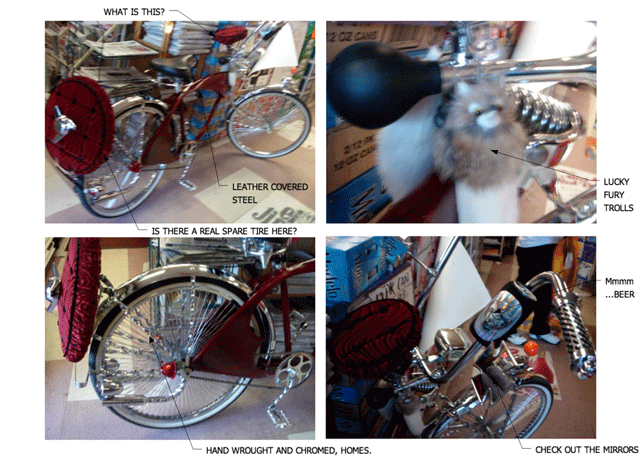
Dropped into House of Spirits in Echo Park and in rode a homeboy who's running his own American Chopper operation.
Sin City
When I told Phil how I would title this blogpost, a big smile came to his face. For a young man, Phil has a grizzled face. Smiles for him don't come cheap. He was the first to tell me about Netflix when I returned from Spain last year and he recommended the first movie I should rent, something called Sin City. Phil was sleeping off the all nighter installation of his show at Black Dragon Society. In record time, he installed two big paintings and a kind of mural on the back wall facing the entrance.
I mentioned the comparison to David Salle's painting (the thoughts of writer Michael Ned Holte, as we were talking the other day), about Phil's use of the floating superpostition of images. I mentioned Rosenquist and Phil was fast on the association, weighting the latter more than the former. I thought of his F-111 and the big show of his I saw in Houston.. The immersion and (institutional) scale is a dizzy direction to look into.
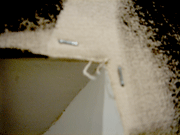
I noted the back wall install and I asked why he (Phil) didn't turn the corner when his canvas came to the door and window openings. Is it possible that for you architecture is another name for painting's support? Was gypsum/wood/stucco equivalent to stretcher bars? And if painting was immersive, was he thinking in terms of the 1998 movie "What Dreams May Come", where the audience was intended to enjoy a literal insertion into paint? But by not turning the corner, Phil stopped short of architecture. According to him, its purpose was to set a stage for the other two paintings in the show.
A stage.
Was mood setting this important?
Yes.
What was the mood, I wondered?
Dark. Brooding. Noir.
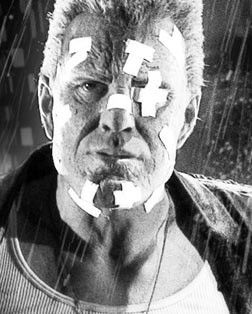
Sin City.
Frank Miller's Sin City. No wonder it was Phil's first movie recommendation for me. Phil is Marv. Even the interior of Phil's studio can best be described by Marv's image: holes punched into the walls, rough patches covering them, cheap office carpeting soaked in paint and glue, heaps of spent art materials piled in drifts in the corners... I cut and paste a section of the Wikipedia description for effect::
...Despite his presumed Catholic upbringing, Marv is a violent, borderline psychotic who uses his tremendous strength and fighting skills to bring down those who challenge him or break his personal code of ethics.He suffers from an unnamed mental condition that causes him to "get confused", which, judging from his own awareness of his illness and the effects it is shown to have, probably involves short-term memory loss and possibly hallucinations. Lucille, his parole officer, supplies him with medication to control these effects of his condition. Lucille's girlfriend Claire, a psychiatrist, supplies Marv's drugs and once tried to analyze him, but he claims she got "too scared." He doesn't seem to be supplied with anything that curbs his violent impulses, however.
Marv is convinced that he is not that smart, but he shows a surprising amount of intelligence when needed, noticeably an ability to logically deduce confusing and complex events. However, in most situations he just smashes his way through conflicts, such as kicking down a door and sending police flying, or charging a squad of heavily armed cops whilst only armed with a hatchet.
Marv has a well developed skill and appetite for torture; he never blinks or seems to think twice about inflicting upon his worst enemies the slowest, most painful death he can possibly implement. He speaks in a soft, calm manner, showing no sign of hesitation or fear, even while committing gruesome killings.
While he has no compunction about maiming and killing anyone he feels has wronged him, even he has his limits. He is deeply afraid of winding up as "a maniac [or] a psycho killer" and thus will only kill someone if he "knows for sure he ought to", making it a point to not kill those who have not earned it. He adheres unrelentingly to his own personal code of honor, which also dictates the repayment of debts and chivalry towards women. He may also have a soft spot for children
(This comparison is not a literal one, a reminder for the literally minded.)
Through the portal that leads to the backroom, one can see two portraits of Phillip Guston and Frida Kahlo. In them, I see ramifications of Phil's dark and hard superpositions. The faces of these two icons are rendered in the way the police use facial composite systems in (I'm thinking in terms of the transparent plastic of ye olde days) overlays. Outside of the brawny scale and Pop references, the somber slip of the facial components reveals some kind of hard grey monochrome (Richter's early work comes to mind now) where visual tropes float fitfully overhead.
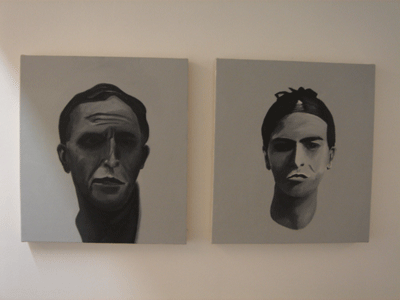
January 21, 2007
Jacques de Beaufort

I bumped into an old friend, Jacques de Beaufort here in ChinaTown last night and I wanted to drop a note into the blog and include a link into the Soup. Good stuff, lots to click through (recent visits to artists like Steve Canaday, supercool), and be sure that you find his parallel blogs wyncko and professor Jacques too.

January 20, 2007
January 19, 2007
Colourful Thoughts
The Economist talks about colour:
In the more recent of the two, which appeared this week, Terry Regier, of the University of Chicago, and his colleagues, picked at the question of preconditioned language categories. They used a grid displaying all possible hues rolled into a globe, with black at the north pole and white at the south. In this model, colours stick out from the sphere according to how sensitive the visual system is to them. Bright yellow, for instance, is easily noticed against a background of other colours, so the yellow part of the sphere bulges. Overall, the knobbly globe has exaggerated, smooth mountains with valleys in between.If humans really are hardwired to home in on six focal colours, then all languages should assign words around those six. Dr Regier, however, tests a subtler concept. He thinks that useful languages should allot words in order to minimise the perceptual difference between colours of the same category, and maximise it between colours in different categories. Unlike national boundaries, linguistic boundaries should form only in the valleys of his colour globe, never over the hills.
Dr Regier therefore programmed his computer to find the best valley borders according to whether he told it to create three, four, five or six ?countries? on the globe. Then, to judge whether people build languages around what their brains are best attuned to, he compared these theoretically best divisions with real-world dividing lines.
Gil Sanchez's 1905 adobe
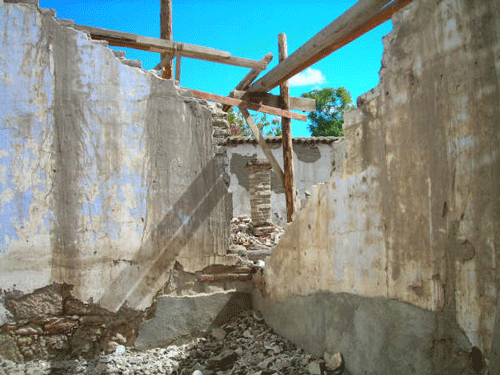
When I was a boy architect, I apprenticed with Gil Sanchez, my mentor. He sent me pics of a job he is doing in Mexico, I asked him for some details:
It's a 1905 adobe. Project is about a half a city block in size. Used to be a grain storage place, they also use to keep bulls, cattle, ...things like that. We are converting some of the rooms into hotels guest rooms, adding new ones, developing a commercial Kitchen for parties, toilets for the big parties, the town is known for it's fiestas. Large patio. It will also have a guest Kitchen, the traditional type. As you can see, it's all hand work! It is a very interesting project as it is in one of the southern states of Mexico, one of the poorest. So they do things differently than they do in northern Mexico and of course in the USA. I go once a month for a week. The owners have a home across the street from the project. The owners are two good looken sisters, not married! 8-)What a great guy.
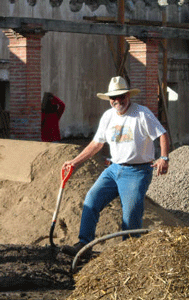

Dr. Faustus

Even though I nominate this name (the blog title) for the new bot (see editor's note at the bottom of the link), I still want Apple to get on the new intravenus grandchildren of the MacPro:
"I think the use of this sort of technology is like any other technology in the sense that it is subject to the desires, for better or worse, of the people with the ability to make use of it," Friend said. "In light of human history I wouldn't be surprised to see the entire gambit from dystopia to utopia played out in miniature here. Even so, I remain optimistic."Same here.
And yet still, the choice of stopping the momentum of modernity seems worse than the dystopian edge we hazard (the former downfall is a certainty, the latter a probabilty/possibility)... so long as we struggle against it as we go along.
(Link source.)
SYSTEM TEST
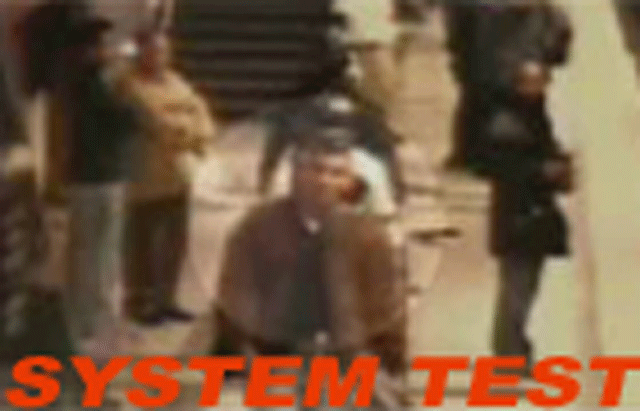
"This is something that's never happened before."
(Thats how they got us last time.)
Goodbye, my friends
Whats it all about, Alfie?
Is it just for the moment we live?
Whats it all about when you sort it out, Alfie?
Are we meant to take more than we give
Or are we meant to be kind?
And if only fools are kind, Alfie,
Then I guess its wise to be cruel.
And if life belongs only to the strong, Alfie,
What will you lend on an old golden rule?
As sure as I believe theres a heaven above, Alfie,
I know theres something much more,
Something even non-believers can believe in.
I believe in love, Alfie.
Without true love we just exist, Alfie.
Until you find the love youve missed youre nothing, Alfie.
When you walk let your heart lead the way
And youll find love any day, Alfie, Alfie.
(Lyrics)
January 18, 2007
John Pilson- INTERREGNA
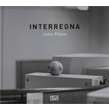
John shows with me at Nicole's place, a good man he is.
He has a book that brings Vermeer* to mind:
JOHN PILSON
INTERREGNAHatje Canz, 2006: 128 pp, 59 duotone illus.
These photographs document a pre-9/11 moment?the officescape of a 24/7 investment bank at the height of the dot-com bubble, where John Pilson worked as a computer graphics operator on the graveyard shift. Using the opportunities provided by the ?dead time? of late night and early morning, he began to explore this space using still and video photography. The expected elements are all present: cubicles, fluorescent light, smeared gray carpet, beige boxes. The landscape of New York?s financial district, seen through windows, provides the occasional background. A clue to Pilson?s discoveries here is provided by the title Interregna, ?between the reigns,? meaning a period where authority and structure is suspended. This important body of work provides a troubling record of our inability to understand and therefore control the effects of technology and work on our lives.
$45 USD
Contact the gallery or visit
www.nicoleklagsbrun.com/publications.html for information. -----------------------
Opening February 2nd:JOHN PILSON
CONTEMPORARY ARTS CENTER CINCINNATIFebruary 2 - April 15, 2007
44 East 6th Street
Cincinnati, OH 45202For information and directions please visit http://www.contemporaryartscenter.org
*A thermonuclear Vermeer.
Posted by Dennis at 1:04 PM | Comments (0)
January 17, 2007
Near Dark
Here is the statement for the show Neal Rock is curating at the Donna Beam gallery in Las Vegas:
Curated By Neal Rock. Show runs Friday January 19 - Tuesday February 12th
Text by David Edward.
___________________________
Near Dark
Caroline Castano Gordon Cheung Peter Lamb Stephen Hendee
Pearl C. Hsiung Dennis Hollingsworth Neal Rock
January 19th ? February 9th 2007
In 1987 rookie film director Kathryn Bigelow completed ?Near Dark?, exploring her interest in portraying contemporary, identifiable heroines within the bravura of ?masculine? film genres. Using much of the main cast (bar Sigourney Weaver) from James Cameron?s Aliens, the film was released only to be engulfed by teen phenomenon, The Lost Boys.
It was, to all extents and purposes, a film resigned to the video market. Relegated to those dusty back shelves and discovered by accident when finally running out of options on a Saturday night rental.
With Aliens? cinematographer (Adam Greenberg) to boot, the project was indeed a Frankenstein?s patchwork of other filmic talent. But later, the Gothic Western found its audience, fragmented and dispersed across the US, in those very back rooms on the edge of boredom and in search of something.
The objects in this exhibition structurally echo the journey of this film, in its search for an audience and within the characters of the narrative. They invoke a mixing of genres and subject dialogues and appear to us darkly, at a side glance, in a space permitted within an afterthought. Although some might appear comfortable as a recognizable way of making that much loved and hated thing called art, on closer inspection no one here is ok with things.
At the Donna Beam gallery in Las Vegas, these artists are still stuck in the middle of somewhere, trying to figure it out? a way to be, in the skin of something that doesn?t quite fit but has to somehow, there?s little choice.
In these ?worlds? any narrative is handled with trembling hands? it is as the west coast artist Allan Kaprow stated somewhat prophetically in 1974 ?Today there are countless artists and reproductions, countless gods and cosmologies. When ?the one? is replaced by ?the many?, reality may be perceived as a menu of illusions, transformable and replenishable according to need?. When the many is replaced by the indivisible even, does it matter where the dust falls at all?
David Edward. London 2007
January 16, 2007
January 15, 2007
Ahora (Sorta)
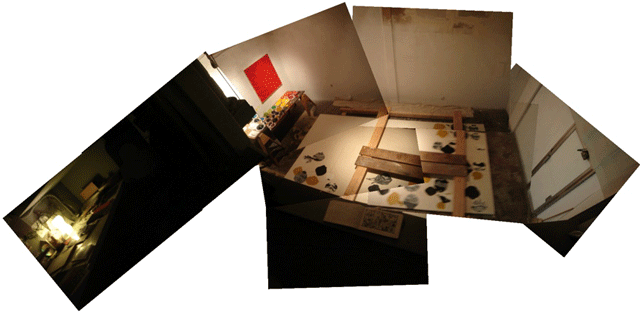
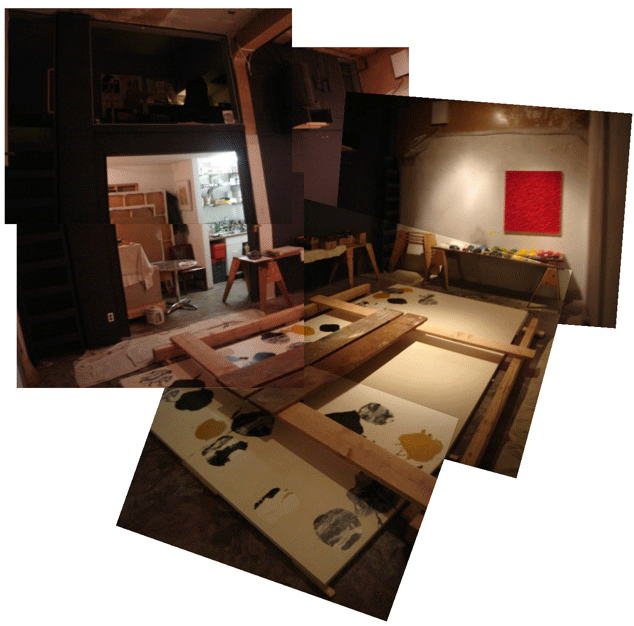
Lots of "Crouching Tiger, Hidden Dragon" going on atop the boards.
January 14, 2007
Cirrus Opening
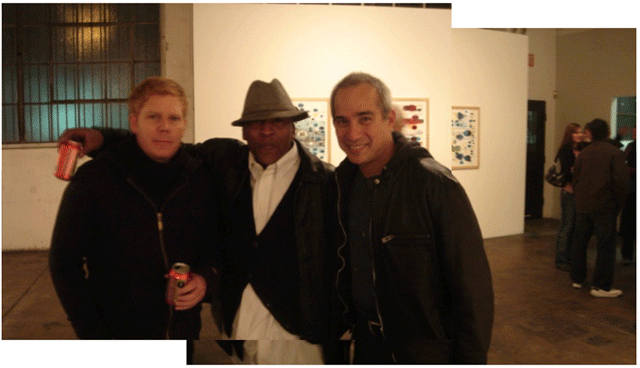
Two of the trio shown here (Bart Exposito and Henry Taylor) are not the artists featured in the opening at Cirrus Gallery last night. Mega mea culpa... I failed utterly in documenting the presence of artsts Todd Hebert and Jason Meadows at the show. Bad, bad, bad. Self flagellation with slender sharp lashes. BAD Dennis. Mea culpa maximus.

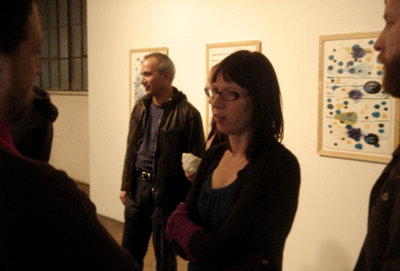
I can't seem to get over the feeling of social exploitation and risk of dampening lively conversations with a camera lens. As you might notice, I've been using movies more often in this blog... and there are many scintillating conversations that I would like to capture without killing the butterflies. Last night was no exception at dinner at the Silverlake restaurant The Ciff's Edge with Todd Hebert, his wife Lily, Jason Meadows , Jean Milant and of course my wife Stephanie. It was my first conversation with Jason, and he kept the table hot with non-stop pleasant provocations.
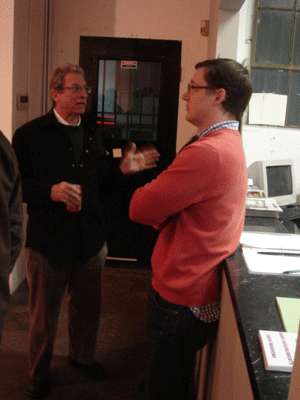
Speaking of provocations, Jason must have had some heavy pheronomes oozing from his pores as we were astonished by the very palpable hit he enjoyed by a passing female stranger who was conspicously flirting with him that evening. Jason was a gentleman throughout. Now THAT would be great on video. Time to bottle your sweat, Jason.

January 13, 2007
Drawings
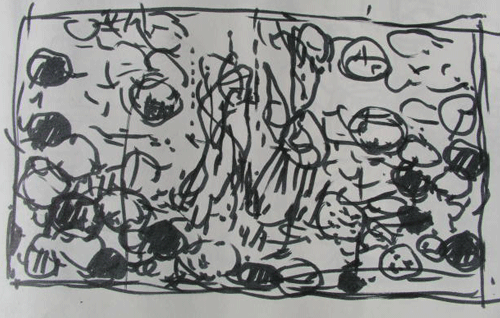
A few drawings in the sequence they were made...
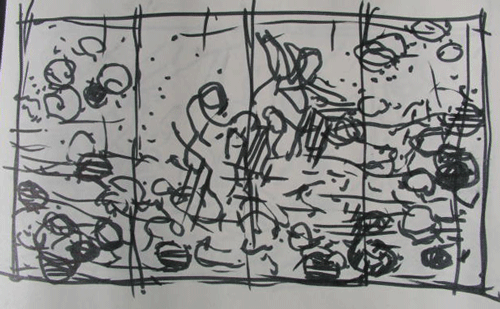
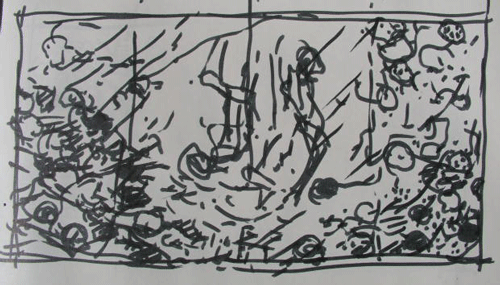

Tom Solomon's "Interventions"
I have formed an idea about Tom Solomon's show "Interventions" (December 16th-January 27th 2007 at Rental Gallery in ChinaTown Los Angeles) but I wanted to get Tom's account of the show before I held forth on the topic.
Here's my first attempt at such a thing in two parts (a bit unpolished, but polish is a bad thing in our artworld, no?):
Robert Smithson
Shannon Ebner
Bas Jan Ader
Gordon Matta Clark
Dennis Oppenhiem
Gilbert and George
Laurie Anderson
Dan Graham
Nick Waplington
Tony Labat
Louise Lawler
Scott McFarland
Jeff Burton
(BLOGPOST IN PROGRESS)
January 12, 2007
This Just In
I've just received this invite in the mail:
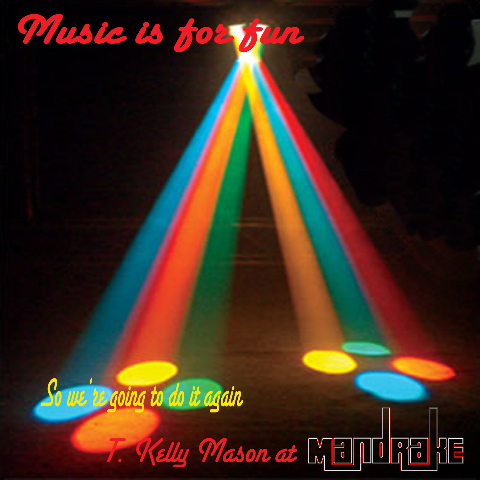
In case you were out
We missed you... ? now the holidays are over.
Enjoy yourself... ? it's later than you think.
Have another go... ? second chances are rare things
We had a laugh ? so can you
This Friday night at Mandrake 9:30 to closing.
T.Kelly Mason will be spinning records. Light Show. Free.
It's gonna sound like this looks.
MANDRAKE
2692 S La Cienega Blvd Los Angeles, CA 90034
(between Venice Blvd and Washington Blvd)
telephone: (310)-837-3297
Snatch
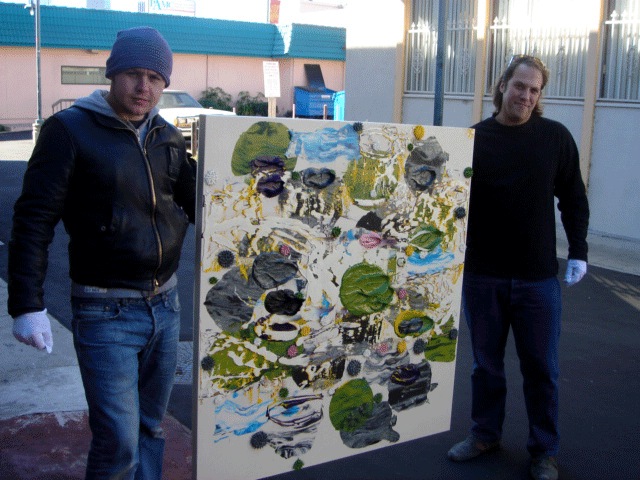
Neal Rock and I have been communicating a bit in the past online and for a while I had not heard much from him. This morning, I got an email out of the blue:
Dear Dennis,
We were in touch a while back regarding a group show that eventually didn't work out. But I'm now living and working in Las Vegas as artist in residence at UNLV, soon to move to LA. I've been asked somewhat belatedly to curate a show at the Donna Beam gallery in Las Vegas. It's a UNLV (University of Nevada Las Vegas) gallery that has had a good track record of shows and I would really love you to take part. However the show is due to open next week and I've no idea if you are around in California and have work available.
It's a very strong line up of artists which you can research on the web if you like. I'm also in touch with Dave Hickey to write a small essay to accompany the show. I'll list the artists below and also give you a contact cell no. to call me, if you can, by today. The no. is XXXXXXXX and it's Stephen Hendee, I'm with him all today and he's not only in the show but helping me curate.
The artists are:
Pearl C Chiung USA
Gordon Cheung UK
Neal Rock UK
Stephen Hendee USA
Caroline Castanyo USA
Kori Newkirk USA (to be confirmed)
Hope to hear from you very soon,
Best wishes,
Neal Rock
(hyperlinks and redacted phone numbers mine.)
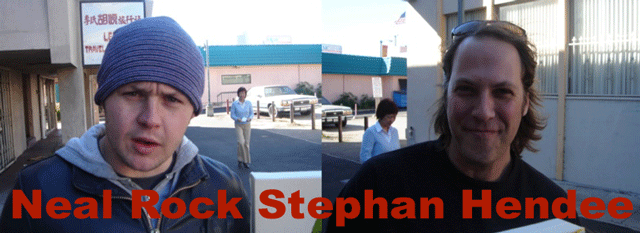
Cool. So I called him back and he happened to be in ChinaTown. Excellent. I got to meet Neal and Stephen Hendee too, nice guys. I've long respected both of their work from afar.
As the Catalans say: "Pim pam poom, bocadilla atun", Neal asked to show one of the two paintings that were available in the studio, I said yes with a signature/title on the back and instructions on how to handle the work, they were off to load the painting in the truck bound for Vegas.
The only downside is that I'm starting work on the big painting and I am probably going to be wrestling with it as the show opens in Vegas next week. So I will likely miss the festivities. I'll fly over as soon as possible afterward. The upside is that I will later have an opportunity to talk undistractedly to Neal, Stephen, Dave Hickey and Libbly Lumpkin... facetime, if I'm lucky.
In Vegas, you gotta have luck on your side.

January 10, 2007
The Future of (Art) School
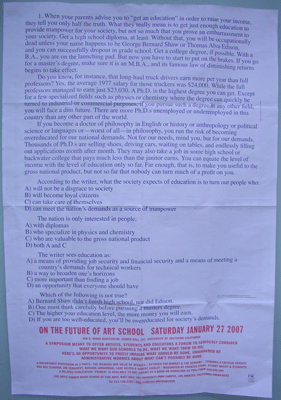
A friend found this in his faculty inbox and passed it along to me.
How lucky!
It's a poster for a soul searching symposium about art school sponsored by USC. Evidently, Lane Reylea showered some sparks over there in a recent visit and the faculty are taking on the topic in a big talk fest.
My hopes are high... and I hope I'm not merely stoned on optimism.

A symposium meant to offer artists, students and educators a forum to seriously consider...
Yes, of course, seriously. Maybe this is a precaution against excessive irony?
Strange, isn't it? By becoming masters of irony (sipping non lethal quantities over time), we seek to control its coil and turns.
That's called hubris.
...what we want our schools to be, what we want them to do;
That's kind of tricky, "what we want them to do". Most artists deep down just want art school to deliver success and not much else. Intellectual ideals are hamstrung by a stultifying dialog/ideology, an incredibly narrow discourse and intellectual terrain. We are victims of our own success, a story as old as mankind. Any effort to take down the fences in this territory will be met with a withering defensive counterattack.
...here's an opportunity to freely imagine what should be done,
There it is, the tacit admission that our discourse isn't naturally free. Maybe it's because freedom is not greeted with pleasure in our artworld?
...unhindered by administrative worries...
Astounding. An admission that the administrative cohort in the academy is a controlling force?
Bureaucracy is a natural enemy of art.
...about what can't possibly be done.
A lot of convulsive truth telling going on here, people. Evidently, we live in a world where possibilities are denied... is this the artworld we've created together?
A roundtable discussion in 3 parts: the meaning and value of degrees...
In a major where the terminal degree is a Master (meaning that there is no PhD program for the fine arts, the term fine denoting final), the academic certificate is lesser in meaning than the subsequent artwork it is meant to inform/inspire. I guess this is true for every degree program, but the distinction is arched for the fine arts where the advanced studies is supposed to occur in the artist studios after school. Interesting, that the academic world isolates and distances itself from art production. Maybe it's because artwork exists on a level that is the subject of research and contemplation?
/ between the market & the academy...
There's not even a sliver of light in the space between the marketplace and the academy. It's seamless. Do I need to cite evidence? In the way dealers roam the hallways of grad art school studio programs? With students selling work in the four to five figures? With the instrumentalization of critical theory as a sales tool? In the way art school has taken on a vocational school agenda? With our eyes blind to the wild west nature of the art world, the conflicts of interest, the defacto insider trading, the compicity with recurrent tulip mania speculation?
Don't get me wrong here. I defend the marketplace, our modernity, our capitalism that has fed so many more people than ever before, that has raised the standard of living worldwide so much so that more artists than ever can reasonably expect to be able to make art and try to pay their bills to make more art. It's just that we have lost sight of the role of intellectual reflective contemplation, aka the academy. The agenda of this symposium is evidence enough of this. I think the main culprit is an overripe postmodernity and our unwillingness or incapacity to overhaul it with a vigorous shakedown critique of the past fifty plus years of recent art history.
We were taught to question authority but now that we have become the authority, we became authoritarians, preventing ourselves from questioning ourselves. ?Que pena! ?Que lastima! But we can yet turn things around, can't we?
...can't we?
/ towards a critical faculty.
I guess "critical" is a postive appellation meaning independent, serious, rigorous, intellectual, thoughtful... is this an admission that we aren't there yet? "Oh, where's the criticality? Over there? Are we there yet?" If the faculty of our art schools have not been critical thus far, what have they been?
I google:
Mai Abu Eldahab
Jan Verwoert
Howard Singerman
Lane Relyea
and Robert Linsley
Moderated by:
Frances Stark
Stuart Bailey
and students
A Related Publication "primer" is available to buy (cheap) as a book or download as PDFs from www.lulu.com.
I tried to find this publication, to no avail. I have an email in to the school to get the name of it, more to you all later when I know more...
Glimpse at a World Forbidden
What is your first memory of technology?
My first tech memory was the reel to reel tape recorder my mother used to train for stenography back in the 60's. Then came answering machines, pagers. Computer classes in college in the 80's involved the punch cards. After undergrad schooll came the Mac classic. Cell phones. I remember the dawning realization that architects could take on bigger projects with smaller staffing. The profession of architecture changed radically that way. Then the internet came on strong in the mid nineties.
Technological change disrupts social networks. That's cool, they spontaneously reform again anyway.
This morning, I read this post from The Belmont Club, drawing dotted lines into our artworld:
The cell phone story in Kenya represent a liberation moment that neither elite had intended to offer them. And they will endeavor to close it out. To some extent, blogs perform the same function as cell phones. They are little "first Amendment machines" in countries in which neither the latifundistas nor the "guerilleros" have any use for the real notion of freedom of speech. It's not surprising that some countries in Latin America are trying to regulate them. The cell phone in Kenya represents an earnest in freedom, not its full payment. It is a glimpse at a world forbidden, a reminder of what we were meant to be. Not the "masses" but men. "We hold these truths to be self-evident, that all men are created equal, that they are endowed by their Creator with certain unalienable Rights, that among these are Life, Liberty and the pursuit of Happiness." Dangerous words spoken by true revolutionaries.(Emphasis Mine)
Along the lines drawn by Arnold Kling, after the end of the legacy of artist-as-courtier, the artworld was a primitive order of small bands back in the hey day of Picasso's Paris... and now we are living at the end of the long era of the limited-access order. Admittedly, the correlation I'm attempting here is difficult if not a bit strained but I think there is enough space between the lines for you to see what I'm seeing.
January 8, 2007
Paul Vangelisti
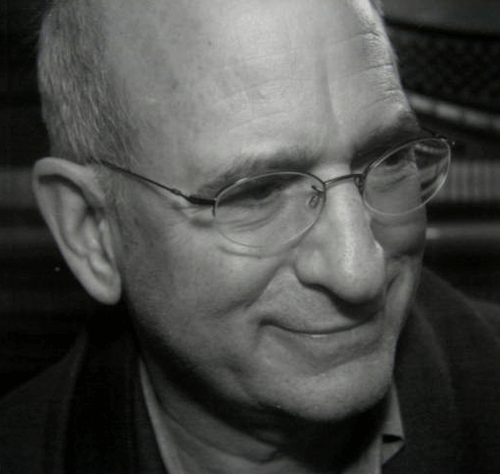
Paul Vangelisti is our neighbor, his property connecting to the street behind us on the fat hill that parallels our on the other side called Cerro Gordo. Paul gave me his recent book of poetry, Days Shadows Pass, published by Green Interger.
It is notable (for me at least) that Paul made a tribute to Bob Crosson. Bob was my neighbor too. Paul generously carved out a portion of his property, a corner of his garage, giving Bob a chance to live out his days writing poetry. There behind the bougainvillea, one could hear the clickity clack of his typewriter amidst a permanent cloud of cigarette smoke. Bob had this habit of writing, wearing only a flannel shirt, a kind of absent minded nudism perhaps. (I never asked why he did this.) So if one heard his typing, it was smart to holler out before parting the flowers: "Good morning Bob!" One beat, two... "Got your pants on?"
Googling, I found a brief description of our "Uncle" Bob here:...Robert Crosson, one of Los Angeles? most important and best kept secrets. Crosson, an actor, housepainter and carpenter, who died in 2001, was one of the most original and provocative poets of the eighties and nineties...
For many years, I would start the day off with a morning visit to Uncle Bob. I knew that Bob was living his end days out there in the corner of Paul's property. He would smoke to excess, and occasionally drink to excess, but it was the cigarettes that killed him. There most mornings amidst the overflowing ash trays and piles of books and journals, he would read his latest work to me and I would show him the stuff I was reading (kind of like I do with you, dear reader, in this weblog).
So it is significant to me that Paul included a tribute to Bob in his Days Shadows Pass. I thought I would scribe it here after the jump:
CareFor Robert Crosson, 1929-2001 How absolute is undressing like history
written or otherwise, unless lying in sickbed
the old before the young relying on instruments
to exert every form of hope or desire.But who cares anyway like a call of doves
as in where do you want to die, the nurse asks,
in the park? And yeah, in the park, he replies
anywhere. I'm telling you, except here.Caring is the curious load blossoming after the war
with everybody using it to reveal everything
about the other - lovers, friends, mothers, fathers, lawyers,
even the wealthy seizing up the poor.So despite appearances, one can't seem to avoid
the season, the all too languorous close
of summer, another school year and the cautious
if continuing intimations of one more failure.Or else you visit by now suspicious looks
in front of or within, whom or him anything
to hold onto, slowly curl all hands around,
folding dumb light day or night this way or that.A lack of gush or ordinary speech as when
time is missing, suspect in the most banal way
measured like something hopelessly essential
like good appetite, tomorrow, a couple more days.It seems three - quarters of his life was greatly exaggerated.
Four or five unopened letters are all he left behind.
Discipline is the one way to account for the disappointments.
Even with the overcast tomatoes need lots of water.Louder than that and who wouldn't notice a long bark
more than a wail or scream, every few minutes or so
the nurses and cleaners look away trying not to notice,
the patients roll calmly by, the stronger even smiliing.Wheelchairs harden that perfectly formal grace
to droopy mouths and shoulders, raw eyes and hands
wheel the boldest up and down the hallway's dream
of someday when you'll want that barking scream.That same distinction between nature and grace
glimpsed in an empty bar at the end of a chapter
in too large a hand embarrassed right out of
the jingle jangle passing in the hunt for language.Who can tell what wanting does or doesn't do
as he tugs the wheelchair in a circle forgetting
to release one wheel reminding me the damn thing's
broken and a new one is in order any day.Like thousands in the dust working in and out
wounded by what he saw fifty years ago.
Something something something to shut you down.
On the street of tough guys and cookies he's a swan.Never has he __ someone the way he __ you.
unless a fervent young boy who love to clap
healthier than anybody in this arena
all arrayed like a holiday come too soon.Firmly depending on whose sense of economy
how lollipop waltzes or checkbooks laugh and sway
how much joy there is to dream shades of Biarritz
or Palma or somewhere these days equally outr?.They likely have a name that can't be said,
they dance in the streets when we aren't staring,
as uncle B has many times reminded us,
don't ask, you will find out sooner or later.Rivers and pools and partridges and a propensity for
growing uninterested in the human condition
whatever that might even turn out to be.
Trying at least once a day to visit him there.Question is who would bother to read anything
about anybody in a place like this.
uncle B himself said. And then look in his eyes,
around you, at all those lolling heads seeming to nod.Or something else we/they do in quiet concession.
Letter after letter a white moth leads to the finish.
When we come kissing the speech flows out of the hand
as lips move to a silence that isn't a way of seeming.Phraenum slit under the tongue to remove a troubling lisp.
How you holding up, what'll you do like the blue dot
on a white moth wing there at the end of an ordinary
afternoon not unlike the will to bark from a wheelchair.Tongue is one way of believing in what came before
passing like a bad day of losing keys or glasses
misplacing a number you've been looking for for weeks,
wondering if all will be less furious now summer's over.Under the full grace of a moon is how you recall
those brief autumns on the hill, tipsy with everything
least of all spirits, much less deliberate than here in this
willful room for nothing but the stink of resistance.Contrition you might have said of the droopy heads
nodding in wheelchairs to the upbeat of gospel piano.
Opposition in the turn of an ear the bend of a stair
leading up above the eyes to that smallest of victories.
The fuel of this resistance is unspeakably full
of whatever most vile whatever most we build
over and upon ro accelerate our daily lives
leave behind that locus of desperation.Yesterday afternoon or was it the day before
the wheelchairs circled a token effort on the floor
of the TV room - hushed unwavering fraces
and the small foul x that marked the spot.Guns and drinking water was what they bought,
The lost nibble through the offices of rhetoric.
guns and drinking water was waht they wanted.
Or so it goes breaking the rule of what they love.
Next Saturday as odd a least as any day.
You know, like what can I do, what can I say.
Everything's here for us from armadillos to.
The rest is zebras, dearest Bob, that last real world.
January 7, 2007
Todd Hebert Opens at Mark Moore Gallery
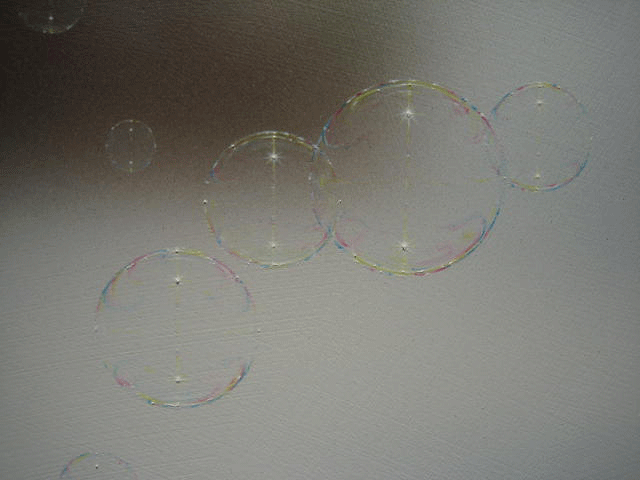
(Detail)
I hitched a ride with Jean Milant to see Todd Hebert's show that opened last night at Mark Moore Gallery. Here's a blurb from the gallery website:
In this series of work, Hebert uses his signature airbrush technique to juxtapose bubbles and snowmen in contrasting planes of perspective. He positions these precisely formed characters in unpopulated backyards that are ?too strangely lit, too moody and impossible, to reflect the real world,? as Jessica Hough from the Aldrich Museum muses, ?we naturally want to bring the image into sharp focus so that we can see all of what we think is there. But then we realize that the beauty and appeal of the paintings is in part due to this gossamer fog that cloaks the landscape.?
Some thoughts:
-Check out the little tiny impasto dabs, cousins of the monad. The tiny shadows from the spot lights are essential to the image, I think.
-The bubbles have high chroma relfections, a kind of mirror that indicates the prescence of... you? Todd?
-My first thought when I first zeroed in to the bubble (funny, too, that one zooms in and out taking in close and long views at their full extents) was that perhaps Todd scribed the form in with a bottle cap as Frances Bacon did, a form of printing. I wonder if he did it this way? Certainly, it would be nerve wracking to hand draw perfect circles otherwise.
-There is a reflection of Richter, perhaps? Gerhard's famous blur paintings are simultaneously invoked and denied: a blur delivered by machine (air brush) versus one dellivered by hand (Richter's brushed alla prima schmear), a reversal of Richter's subordination of painting to photography, a denial of the blur of the long view by the inclusion of the close focal plane of the bubbles, an acknowledgement of photography in a larger way that loads up the bag of painter's tricks...
-I like the celebration of wonder, something natural for children and something furtive for adults who forgot they were children once.
Here's a 35 seconds of the show:
January 6, 2007
Ahora
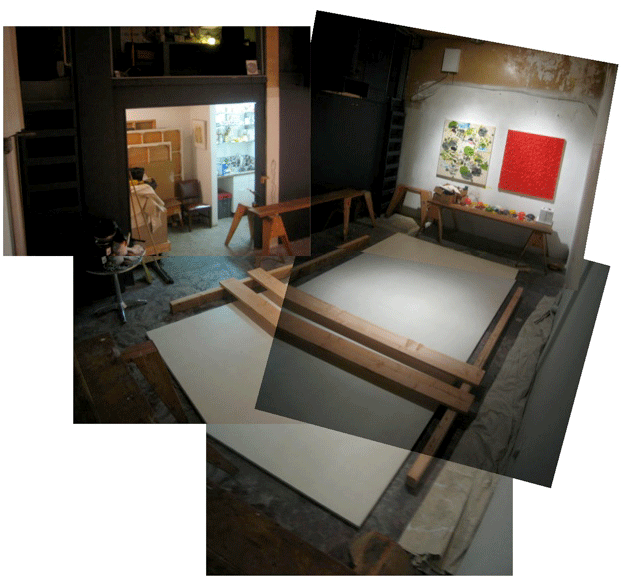
Four pieces of wood instead of twenty plus.
Whodathought it would be so easy?
Not me, I guess.
Somtimes you defy gravity, other times you respect it.
Studio Visit: Adam Janes

I dropped into Adam's Frogtown studio last night to say hello. He's moving to another one in Alta Dena and I wanted to see what he had going on before me makes his move.
He's working for Richard jackson, an artist who has tremendous momentum in Europe, but not well enough known here stateside. Adam flagged the video taken of Jackson as he was musing about the artworld, while cleaning the harvest from a recent hunting excursion. I'd like to meet Jackson someday.
Adam works in ways that I can relate to. He organizes his work into projects where all drawings and objects serve a kind of "client" (see the titles on this page), an imaginative objective or subject for which all his actions serve. His formalism is garrulous, composed of many elements in a language or typology where each piece interlocks with another in a specific way. He defers a final resolution (a phantasmogoric abstraction perhaps) so that the objective nature of his imagery never finds rest or comfort in a singular visage. Contrarily and without contradiction, he uses the conventions of painting/sculpture as models to navigate by: portrait, landscape, still life, etc. He beleives in chops, drawing, he's a monster for drawing in all its variants.
I asked him to talk about his "Johnny Jump Up Relaxus Pantium Protectus":
Adam used to work for Paul McCarthy ("Papa Smurf", his people call him... I think of how Joseph Bueys was called the "River G-d") and now Richard Jackson. Both artists have become natural exemplars for Adam, inspiring him to think in similar ways (in terms of his sense of humor, imaginative process and approach to practice, a fond appreciation for innocent childlike wonder). Conversations with Adam feels like his work: full of suprising turns, humorous asides, cartwheeling associations, ocassional erasures and backtracking, knee slapping guffaws...
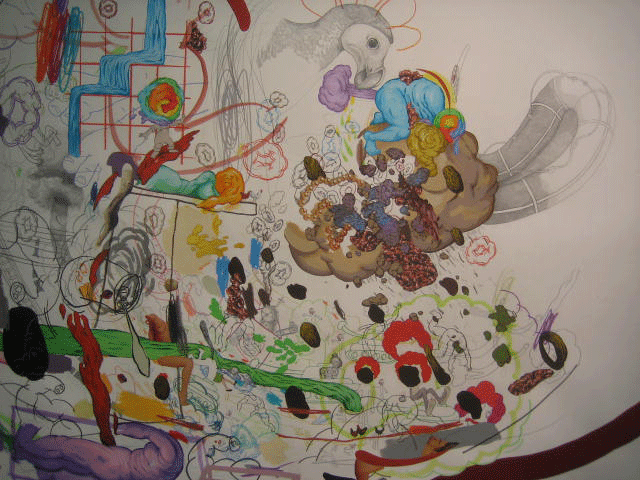
January 5, 2007
Cirrus Opening: Jason, Dennis and Todd
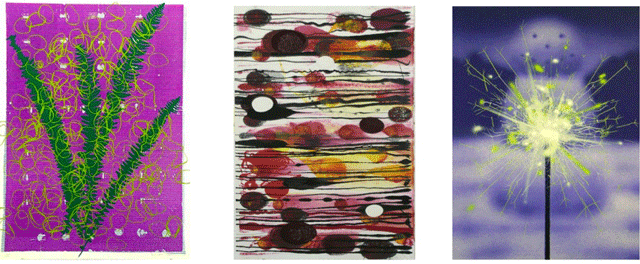
Cirrus Gallery Opening:
Monotypes by Jason Meadows, Dennis Hollingsworth and Todd Hebert.
Saturday, January 13th, 2007
Reception: 6-8 pm
I should have figured it out when I watched Joel Mesler buy his first offset printer years ago. Back then, Joel had a space in ChinaTown called Dianne Pruess Gallery where he ran a press, a speakeasy and a music studio down in his basement. He was moving in the direction of publishing, open to the idea of making editions of anything at all: traditional art, music, film, anything. It was notable at the time that what was beginning to happen was that young artists were seeking out small presses to make work with.
Maybe it was because prints had an underdog status in the art world, it seemed like the runt of the art object litter. A print was not as highly regarded as "original art". Sure, there were the great print houses that made editions of the heros of the 60's, but they have come and gone and a shadow was left in their wake. And sure, the editions concept was already applied to artist project multiples, but this is some distance from the traditional machine press on handmade paper, and with the distance from the perceived inferior status came more prestige. Prestige, the blood of the artworld. That was then. Things are changing now maybe because so many young artists who have sought this medium out have now acquired a status of their own, maybe because all things get commoditized in time, maybe because the marquee has to change after all(see artist's anxiety). Finally, in our era of the top dog underdog status imparted some appeal to the medium.
People seem to realize what the artists have seen for some time: that the industrial age process of printmaking has finally justified itself (again) as a medium. Maybe it has happened now because of the hands on aspect of printmaking or that the history of printmaking has generated an a broad array of apporaches in technique and therefore a wide range of expression.
Owner of Cirrus, Jean Milant has put together a show of three editions: myself, Jason Meadows and Todd Hebert to show people a little bit of this bloom.
Jason's work is energetic and yet casual and impromptu. Seeing the prints and hearing the accounts of the folks at Cirrus, it seems to me that Jason takes the maxim "Art (material) is anything within your reach" to a hardcore literal level. A handfull of pocket change, coins tossed on the printing plate, ferns fronds cut from the garden, a scatter of rubber bands, plastic six pac ties. Superpositions of loot taken on the fly in the bright chromas of printer's ink.
Todd's prints look like they had a super strong gravitational field of his attention, focused as he is in recuperating representational imagery in art. I was told that he had hand painted atop printed matter, but I think that is only part of the story. When you print an image, it is an assembly of actions that compile into something recognizeable. Working from background to foreground, the final application of the hand is in the same technical system of the machine... if you can place an airbrush on the same plane as a 1950 steel German beast of a printing machine.
As for my prints ("OVEJAS NEGRAS", "Black Sheep"), I would characterise them as something for which the ink itself was the plate (the instrument for imparting ink to the paper) and the machine itself was used like a brush to paint a series of works on paper simultaneously. Processes would set themselves up and from time to time, I disrupted them to find others, such as little adventures working with Victorian end paper processes, French marbling (so as to parallel the machine with ink floating on water instead of steel) or dropping spot applications with hand rollers.
Monotypes at Cirrus next Friday.
I'll see you there!
Needed. Resented.

As one who is born of an American father and a Filipina mother, the history of America in the Philippines is endlessly attractive to me not only for the potential of personal know thyself biographical revelation, but also as a template for understanding our current geopolitical dynamic. Richard Fernandez, author of the blog The Belmont Club has published a fascinating capsule history of The Islamic Insurgency in the Philippines Part I. Sunni versus Shiite? Been there, done that.
Unlike American policymakers a hundred years later, the US colonial authorities had no intention of bringing self-rule or democracy to the Moros. With abundant models of European colonialism available for emulation, their goals were simple: divide and rule while standing off. Ironically this traditional colonial approach would come to be called "realism" in the early 21st century.
Fernandez ends the post like so:
Historically, the modern Islamic insurgency in the Philippines can be understood as a reversion to a lower energy state by the Philippine Republic. It is the consequence of the gradual inability of the Philippine elite to keep hold of the territory that Wood, Bliss and Pershing had acquired on the Republic's behalf. The elites did not lack for avarice but they lacked in capability. Ruling class corruption and sheer incompetence had, by the 1970s made the Armed Forces of the Philippines vulnerable to challenge by the Moros once again. The legacy of the US Army and the memory of its force had finally faded. A young rebel Nur Misuari knew the time had come to strike and take back from Manila what his forbears had lost to Pershing; and his establishment of the Moro National Liberation Front customarily marks the start of the modern Islamic insurgency. The mismatch between the ambitions of the Manila elite and their unwillingness to attain it through effort is at the heart of the current and stormy relationship between America and the Government of the Philippines. Gloria Macapagal Arroyo needs the 'descendants' of Pershing to help keep parts of her territory from gradually drifting away to the Moro nation. As such America is both needed and resented. Rather than meet the Moro challenge with through the path of reform and self-reliant military strength -- which would require giving up corruption and patronage -- the Philippine political system requires a source of help that does not require them to clean up their act. And the obvious source of that help was the superpower with which it had a one-time colonial relationship. The status of forces agreement which permits American forces to provide combat support is an expedient to square the circle; an attempt by local politicians to obtain military effectiveness from external help instead of paying for it by clamping down on their own rackets. And with it comes the ultimate dilemma of "nationalists" without the means to sustain their nationalism; that the maintenance of sovereignty requires giving some of it up.
(Emphasis Mine)
To give up corruption and patronage is to give up the last remaining vestige of tribalism, a line that the Philippines has yet been unwilling to cross, probably because it is the point of no return on the road to modernity.
Needed and resented.
Resented because you are needed.
Needed because you are resented.
January 4, 2007
Lameness, Plus.
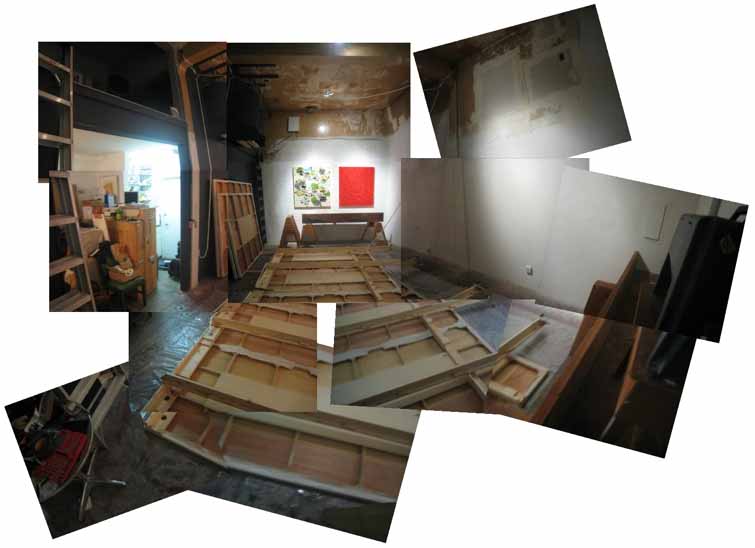
Usually, an artist/blogger should make it all look easy. Don't show the sweat. Betray no fallibility. You're an artist, you must have an eye on posteriety: become the marbled icon, levitate into branded heaven.
Not today and not in this blogpost, people.
I should have known that the weight of the rig I devised was too heavy to repeatedly lift the four paneled 8'x16' painting back and forth from flat to vertical positions which is typical for me when I'm painting these heavy-thick-impasto-wet-into-wet-alla prima works of mine.
I felt more than a little stupid, as if I had just failed an elementry engineering test. The shoulders of the architect in me had just been rounded off a bit.
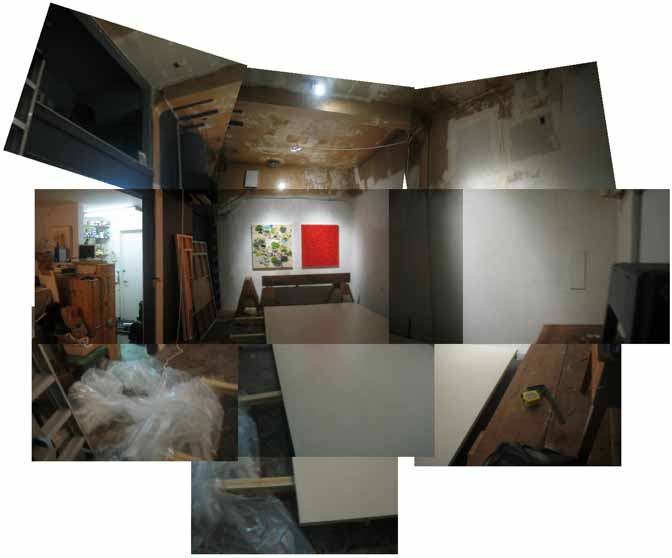
The forlorn strategy: rig up a minimal frame of two horizontal stiffeners top and bottom, and four legs that catch the stiffeners with wheels at the tips so I can hoist the painting between the wall and the floor.
Finally, after a bit of schedule slippage (I wanted to be mixing paint two days ago to start the new year off with brio), having crafted a fine wood butcher's folly*, I finally got into position late last night to call in my friend Bart Exposito to help me lift the beast up. Immediately, we were able to stand the rig up without rupturing our abdominal walls, but then I noticed the strain on the rope that I was hanging on to. I knew that I was pushing the limits here, but it was only at this moment did I fully realise that the burden of weight was too much for me to handle. I was lucky to be able to ease the beast to the ground without rope burned hands or dislocated shoulders. And there on the ground it lay with my pride.
Stubborn reality.
Phil Wagner came in for a look see. He suggested larger pulleys, the increased diameter is a bigger lever arm. I could cut out a pulley from 3/4" plywood in three disks with two different diameters and glue them together. Then, I would have to attach a frame to the ceiling to hold the pulley in place.
I began to imagine a Rube Goldberg set up. The rig was becoming the art. The painting was becoming an installation where painting took second place to a drama about a painting-about-to-take-place. It wasn't that the thought repelled me... I could call up Adam Janes and suggest some kind of collaboration, he's working somewhere in this territory. But nah, don't go nuts Dennis... let's retread here.
The Phil suggested a friend of his who has an engineer's mind, who frequently consults to artists to McGyver solutions to problems like this. Did I want his cell number? No thanks Phil, but thanks for the thought. It was time to take a step back and look what was obvious in this situation.
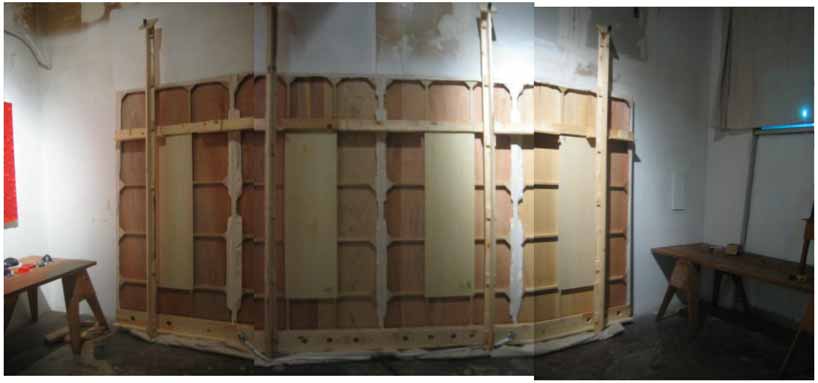
Reality: the painting is too heavy as it is, and it is too insane to expect to flip it back and forth like I did before. So instead of moving the painting, I'll move.... me. The solution was as plain as day: leave it on the floor and move myself back and forth from the loft for a simulated upright view. And how to get into the center of the canvas? Reuse the struts as rails top and bottom and buy another couple of longer redwood planks to span atop the rails and float above the painting as a kind of scaffolding.
Later, Bart and I repaired to Hop Louie for a beer so I could cry into it. The image of hauling up the panels with a pull of the rope was too sweet to let go easily. By midnight, I was over it and planning the next day.
*see defintion #5 here.
January 3, 2007
Deckard Spat.

I like to say that to be a slave is to have your happiness dependent on the actions of another:
Roy: Quite an experience to live in fear, isn't it? That's what it is to be a slave.[Deckard spits at Roy as he falls; Roy catches him with one hand.]
Roy: I've seen things you people wouldn't believe. Attack ships on fire off the shoulder of Orion. I watched C-beams glitter in the darkness at Tannh?user Gate. All those moments will be lost in time like tears in rain.
Time to die.
[Bird flies off...]
Cirrus Editions: Jason, Todd, Dennis and the Monotypes.
Sorry to jot a note on the fly, there's more flesh to grow on this here bone for an upcoming blogpost on a show at Cirrus, featuring Jason Meadows, Todd Hebert and yours truly.
The show, wil be installed this Saturday and the opening will be set for next week, Saturday January 13th, 2007.
(BLOGPOST IN PROGRESS)
January 2, 2007
Wily Crow and Selfish Foxes
Prestige is the blood of the art world:
As the world came undone, the least the Dutch could do was preserve their cultural heritage. To seal the deals, the forger relied on the art world?s overly cozy network of buyers, critics, and museum curators. That world, like all small worlds, protects its own. After van Meegeren?s deceptions were made plain, few people sought to press charges. Most didn?t want to acknowledge publicly that they?d been duped. Others simply refused to accept the truth. One critic insisted that van Meegeren was a boastful liar, and prided himself on having rescued the fakes from being destroyed, as Dutch law dictates.That which is problematic here has several dimensions. After all, the fable implies that all apples are alike and that exeptionalism is a cheap parlor trick. But are all apples all alike? And is art merely a common fruit? Belief is as much fabricated as it is grown, and the fraud indicates the authentic after all. Beware of the tendency to become jaded. Beware, too, of the brand --that shorthand and sleazy shortcut that avoids the difficult territory where art really lives.Van Meegeren understood, as other forgers do, that the stamp of authenticity can trump art. The proof, however spurious and cobbled together, that a painting is by Vermeer (or any other name-?brand artist) is at least as important as the quality of the work. It was enough for the forger to create a plausible resemblance to Vermeer. Van Meegeren?s early forgeries crassly combined elements of authentic paintings, cut- and- paste style, into pastiches. While he eventually became an accomplished mimic, he was never a great painter. But he didn?t need to be, for a painting?s market value derives not just from the quality of the individual canvas but largely from the reputation of its putative creator. Today the art world is not appreciably different. Wynne concludes with an object lesson: In 2004, casino developer Steve Wynn paid $30 million at auction for a Vermeer that is far from the artist?s best? and one not all experts agree is authentic.
Everyone wanted van Meegeren?s forgeries to be masterpieces. The buyers and curators wanted desperately to acquire a Vermeer for their collections. The critics wanted, no less desperately, to claim responsibility for adding one more work to Vermeer?s all- too- slim catalogue raisonn?. And experts such as Bredius wanted to confirm their pet theories. Pride and self- regard colored judgment, and no one truly saw what he was looking at, because no one dared look closely.
The forger?s story may be read as an enduring fable about the art world. A modern-day Aesop might cast the tale with a wily crow and selfish foxes: One day, the crow set the foxes fighting for control of an apple. The apple, the crow swore, was unlike any other in the world, and the foxes chose to believe him. But the apple was really nothing special, and the crow, in the end, was found out and driven from the forest for its lies. But what of the foxes that desired blindly and wildly, and so were fooled? Should not they too learn a moral from such a story?
January 1, 2007
Handshaking
Thanksgiving occurs only once a year here in the States, but gratitude is lifelong. I would like to take the time at the beginning of this year to say thanks to my fellow bloggers who have kept in touch, the recent handshaking online.
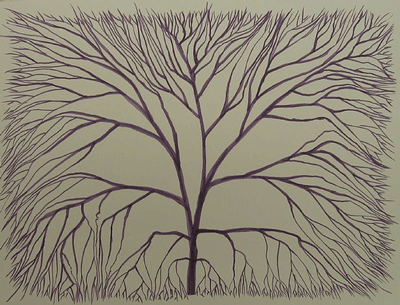
-With Steve LaRose, who noted the gene trail of "3 Blogging Hollingsworths": Neil, Harold and yours truley.
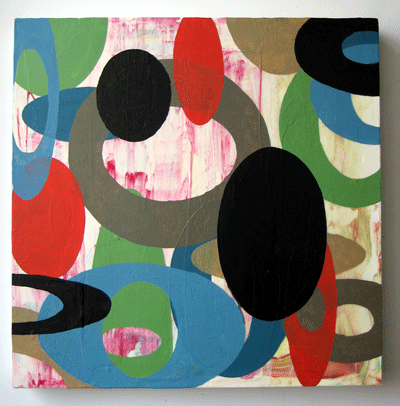
-With "cousin" Harold, who echoed my Dec. 1st 2006 cut n' paste post "Risk, Faith" featuring Kirk Varnedoe's thoughts about abstraction, personal vision and modernity. Those thoughts caught much attention, prompting a few emails and favorable mentions from freinds here in ChinaTown LA.
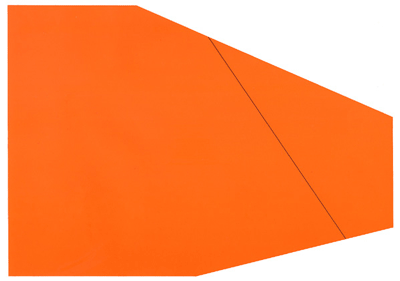
-With Brent Hallard, who was kind to float a recent close up of my red monad field for Tokyo and beyond --good tidings, that. I'm looking forward to meeting up with him this spring and see his world behind his blog.

-With Dean Terry's Metaverse class' MFA opening at UT Dallas. Dean has a film, "Subdivided" that will air on Dallas' PBS station KERA on January 3rd!
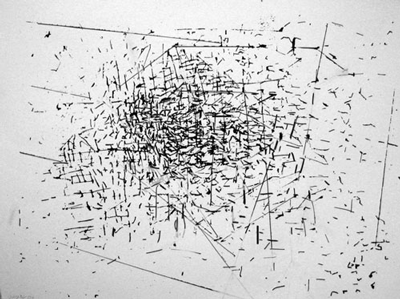
-With Chris Jager's adventurous business venture, "SlideRoom". It's a web service for portfolio submission and review, virtual slide sheets in the house. I put a tag ad up for him in the sidebar.
I changed up to digital fotos in 2003 when we started to move eastward towards Spain. A slide or transparancy has tons of more information than what we normally take in a jpeg (640x480 being the normal setting), but over time, I don't think it will matter so much. What will matter is to take a variety of images in different conditions, to provide fodder for whatever technical framework we will require in the future. Sure, a catalog production will need the rich image density that transparancies provide... but I don't think coffe table books will be a significant feature in our future.
I especially like the prospect of streamlining the various bureacracies that SlideRoom promises (I hate the application processes whether it be for grants or public art or faculty applications or whatnot. With all the information in the web, I wonder why an applicant has to submit anything at all?
Good luck Chris, I'm rooting for you!
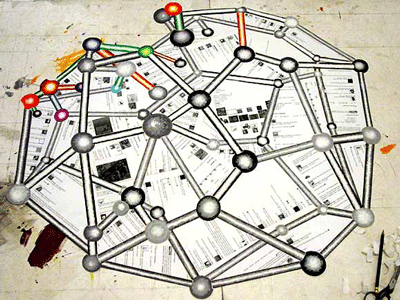
-With Tom Moody, who was kind to post a pocket exegesis on me a few months back. We have shaken hands several times over, and I appreciate his ability to range across media genre free of the hunkered territoriality that sometime afflicts artworld denizens. I especially like how he can appreciate that blogging is a medium in and of itself:
I'm surprised that more artists don't use their weblogs as real workspaces for their art; most that I've seen are in the classic mold of a place to write, link, and gossip- journal-like spaces. What I don't see often enough are webloggers who mine their past posts, reflect on where they've been and where they are now, connect dots, and build a corpus of work. Am I missing others who are doing this?And why wouldn't blogging be another genre, given the range of expressiveness and wide... and free... dissemination? (I sense the prospect of anxiety our there already, once artists begin to grasp this idea. Comodification --and thus compensation-- can work itself out, it always has in the past. What has to happen first is the establishment of value.)
UPDATE:
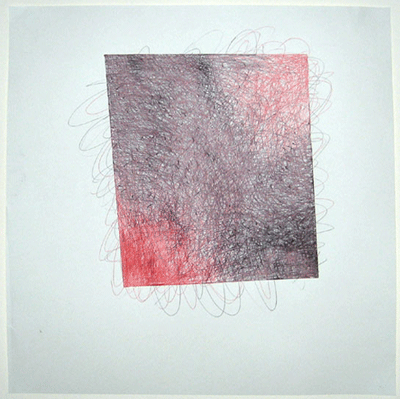
-With Chris Ashley!
Chris is another blogger I should shake hands with in this post... especially but not exclusively since I had mis-attributed his words in Tom Moody's handshake:
Hi Dennis,Yes! It is you, Chris.... my most heartfelt apologies! Chris Ashley is probably the premier artist who is vigorously working the potential of blogging as an art form: writing, sketching from traditional media to HTML code, photography... all excellent, dense and deep.In your new year's handshake I read the following,
which you attributed to Tom Moody:"I'm surprised that more artists don't use their
weblogs as real workspaces for their art; most that
I've seen are in the classic mold of a place to write,
link, and gossip- journal-like spaces. What I don't
see often enough are webloggers who mine their past
posts, reflect on where they've been and where they
are now, connect dots, and build a corpus of work. Am
I missing others who are doing this?"I thought this sounded very familiar. I thought this
sounded like me! So with a little search I confirmed-
yes, the quote above is me, not Tom- it was a comment
on his weblog by me that he was quoting and responding
to:http://www.digitalmediatree.com/tommoody/comment/29051/
It was weird to read something I was sure I'd said-
these ideas are things I've harped on a lot- but had
to confirm it to make sure it was me.Cheers, and Happy New Year.
Chris
UPDATE II:

-With Bill Gusky too! Bill has an excellent blog wherein he too commented on the Varnedoe blurb mentioned above.

By the way... while clicking around Bill's blog, I found an enterprise called Voice Over To Go, a voice acting service for people who don't like the sound of their own voice... like yours truly perhaps. It sounds fun and smart. And I suspect that the proprietor, Eric Gusky is Bill's brother, too. Very Cool.

